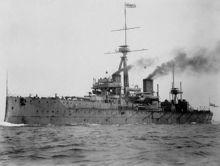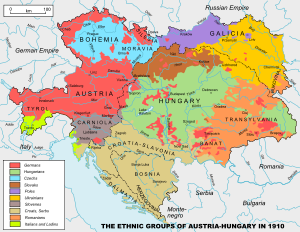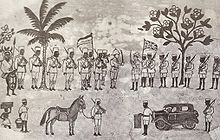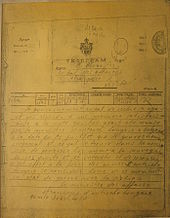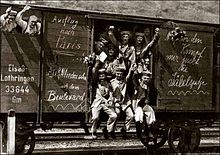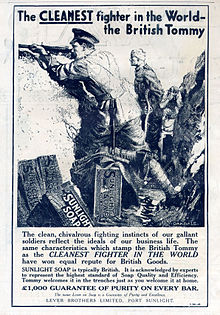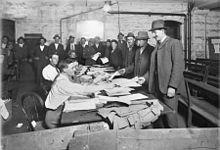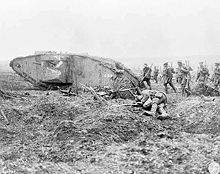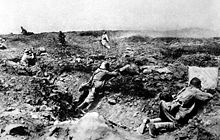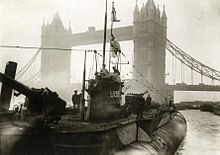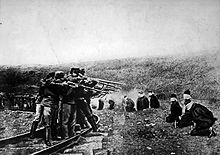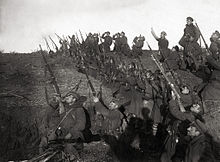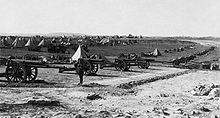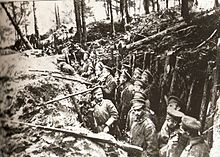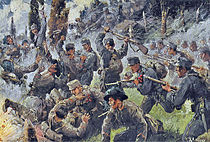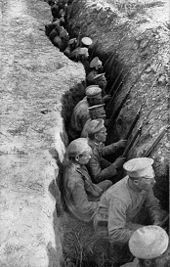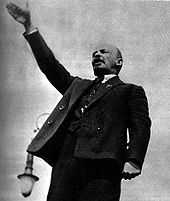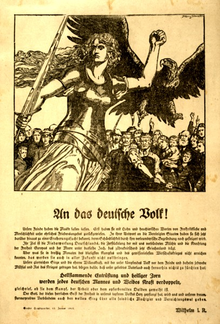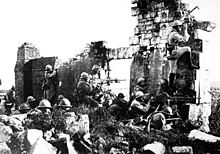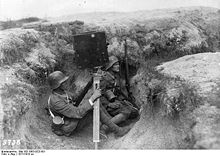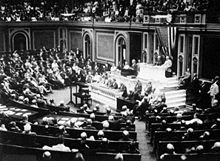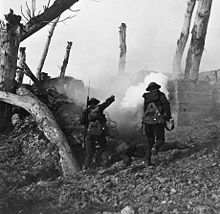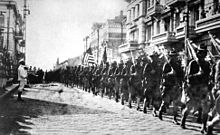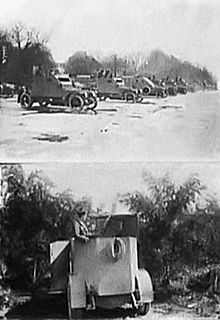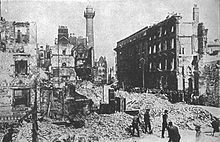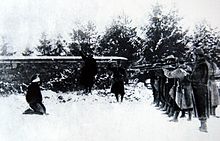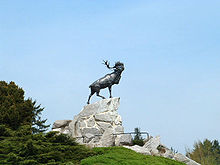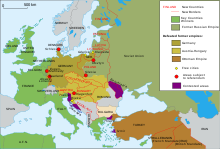- World War I
-
This article is about the major war of 1914–1918. For other uses, see World War One (disambiguation) and Great War (disambiguation).
World War I 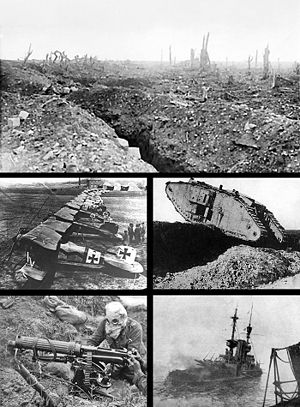
Clockwise from top: Trenches on the Western Front; a British Mark IV Tank crossing a trench; Royal Navy battleship HMS Irresistible sinking after striking a mine at the Battle of the Dardanelles; a Vickers machine gun crew with gas masks, and German Albatros D.III biplanesDate 28 July 1914 – 11 November 1918 (Armistice) Treaty of Versailles signed 28 June 1919
Location Europe, Africa, the Middle East, the Pacific Islands, China and off the coast of South and North America Result Allied victory - End of the German, Russian, Ottoman, and Austro-Hungarian empires
- Formation of new countries in Europe and the Middle East
- Transfer of German colonies and regions of the former Ottoman Empire to other powers
- Establishment of the League of Nations. (more...)
Belligerents Allied (Entente) Powers
 France
France
 British Empire
British Empire
 Russia (1914–17)
Russia (1914–17)
 Italy (1915–18)
Italy (1915–18)
 United States (1917–18)
United States (1917–18)
 Romania (1916–18)
Romania (1916–18)
 Japan
Japan
 Serbia
Serbia
 Belgium
Belgium
 Greece (1917–18)
Greece (1917–18)
 Portugal (1916–18)
Portugal (1916–18)
 Montenegro (1914–16)
Montenegro (1914–16)
and othersCentral Powers  Germany
Germany
 Austria-Hungary
Austria-Hungary
 Ottoman Empire
Ottoman Empire
 Bulgaria (1915–18)
Bulgaria (1915–18)Commanders and leaders Leaders and commanders
 Raymond Poincaré
Raymond Poincaré
 Georges Clemenceau
Georges Clemenceau
 Ferdinand Foch
Ferdinand Foch
 H. H. Asquith
H. H. Asquith
 David Lloyd George
David Lloyd George
 Douglas Haig
Douglas Haig
 Nicholas II
Nicholas II
 Nicholas Nikolaevich
Nicholas Nikolaevich
 Antonio Salandra
Antonio Salandra
 Vittorio Orlando
Vittorio Orlando
 Luigi Cadorna
Luigi Cadorna
 Woodrow Wilson
Woodrow Wilson
 John J. Pershing
John J. Pershing
and othersLeaders and commanders
 Wilhelm II
Wilhelm II
 Paul von Hindenburg
Paul von Hindenburg
 Erich Ludendorff
Erich Ludendorff
 Franz Joseph I
Franz Joseph I
 Karl I
Karl I
 Conrad von Hötzendorf
Conrad von Hötzendorf
 Mehmed V
Mehmed V
 Enver Pasha
Enver Pasha
 Mustafa Kemal Atatürk
Mustafa Kemal Atatürk
 Ferdinand I
Ferdinand I
 Nikola Zhekov
Nikola Zhekov
and othersStrength Entente[1]  8,841,541[2]
8,841,541[2] 8,660,000[3]
8,660,000[3]Total: 42,959,850
Central Powers[1] Total: 25,248,321
Casualties and losses Military dead:
5,525,000
Military wounded:
12,831,500
Military missing:
4,121,000
Total:
22,477,500 KIA, WIA or MIA ...further details.Military dead:
4,386,000
Military wounded:
8,388,000
Military missing:
3,629,000
Total:
16,403,000 KIA, WIA or MIA ...further details.Theatres of World War I- Caucasus
- Persia
- Gallipoli
- Mesopotamia
- Sinai and Palestine
- South Arabia
- South-West Africa
- West Africa
- East Africa
- North Africa
Other theatres:
- America
- Atlantic Ocean
- Mediterranean
World War I (WWI), which was predominantly called the World War or the Great War from its occurrence until 1939, and the First World War or World War I thereafter, was a major war centred in Europe that began on 28 July 1914 and lasted until 11 November 1918. It involved all the world's great powers,[4] which were assembled in two opposing alliances: the Allies (centred around the Triple Entente of Britain, France and Russia) and the Central Powers (originally centred around the Triple Alliance of Germany, Austria-Hungary and Italy).[5] More than 70 million military personnel, including 60 million Europeans, were mobilised in one of the largest wars in history.[6][7] More than 9 million combatants were killed, largely because of great technological advances in firepower without corresponding advances in mobility. It was the sixth deadliest conflict in world history, subsequently paving the way for various political changes such as revolutions in the nations involved.[8]
Long-term causes of the war included the imperialistic foreign policies of the great powers of Europe, including the German Empire, the Austro-Hungarian Empire, the Ottoman Empire, the Russian Empire, the British Empire, France, and Italy. The assassination on 28 June 1914 of Archduke Franz Ferdinand of Austria, the heir to the throne of Austria-Hungary, by a Yugoslav nationalist was the proximate trigger of the war. It resulted in a Habsburg ultimatum against the Kingdom of Serbia.[9][10] Several alliances formed over the previous decades were invoked, so within weeks the major powers were at war; via their colonies, the conflict soon spread around the world.
On 28 July, the conflict opened with the Austro-Hungarian invasion of Serbia,[11][12] followed by the German invasion of Belgium, Luxembourg and France; and a Russian attack against Germany. After the German march on Paris was brought to a halt, the Western Front settled into a static battle of attrition with a trench line that changed little until 1917. In the East, the Russian army successfully fought against the Austro-Hungarian forces but was forced back by the German army. Additional fronts opened after the Ottoman Empire joined the war in 1914, Italy and Bulgaria in 1915 and Romania in 1916. The Russian Empire collapsed in 1917, and Russia left the war after the October Revolution later that year. After a 1918 German offensive along the western front, United States forces entered the trenches and the Allies drove back the German armies in a series of successful offensives. Germany, which had its own trouble with revolutionaries at this point, agreed to a cease-fire on 11 November 1918, later known as Armistice Day. The war had ended in victory of the Allies.
By the war's end, four major imperial powers—the German, Russian, Austro-Hungarian and Ottoman empires—had been militarily and politically defeated and ceased to exist. The successor states of the former two lost a great amount of territory, while the latter two were dismantled entirely. The map of central Europe was redrawn into several smaller states.[13] The League of Nations was formed in the hope of preventing another such conflict. The European nationalism spawned by the war and the breakup of empires, the repercussions of Germany's defeat and problems with the Treaty of Versailles are generally agreed to be factors contributing to World War II.[14]
Etymology
During the Interwar period, the War was known by a variety of names in English-speaking countries. Besides being called the World War and the Great War,[15] which were the most common names, it was also referred to merely as The War, or The War in Europe,[16] the War of Nations,[17] the 1914 War,[18] or some variation on these and other names. Occasionally different names were used interchangeably within a single work, as in a Time article from 1924.[19] After the onset of the Second World War in 1939, the terms World War I or the First World War became standard, with British and Canadian historians favouring the First World War and Americans World War I. The notion that the "World War" was merely the first in a series was not a new idea at the time, however; it was first introduced in September 1914 by German biologist and philosopher Ernst Haeckel, who claimed that "there is no doubt that the course and character of the feared 'European War' ... will become the first world war in the full sense of the word."[20] The First World War was the title of a 1920 history by the officer and journalist Charles à Court Repington. In France and Belgium, the war was sometimes referred to as La Guerre du Droit (the War for Justice) or La Guerre Pour la Civilisation / de Oorlog tot de Beschaving (the War to Preserve Civilisation), especially on medals and commemorative monuments.
Background
Main article: Causes of World War I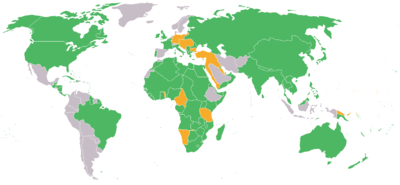 Map of the participants in World War I: Allied Powers in green, Central Powers in orange, and neutral countries in grey
Map of the participants in World War I: Allied Powers in green, Central Powers in orange, and neutral countries in grey
In the 19th Century, the major European powers had gone to great lengths to maintain a balance of power throughout Europe, resulting by 1900 in a complex network of political and military alliances throughout the continent.[5] These had started in 1815, with the Holy Alliance between Prussia, Russia, and Austria. Then, in October 1873, German Chancellor Bismarck negotiated the League of the Three Emperors (German: Dreikaiserbund) between the monarchs of Austria–Hungary, Russia and Germany. This agreement failed because Austria–Hungary and Russia could not agree over Balkan policy, leaving Germany and Austria–Hungary in an alliance formed in 1879, called the Dual Alliance. This was seen as a method of countering Russian influence in the Balkans as the Ottoman Empire continued to weaken.[5] In 1882, this alliance was expanded to include Italy in what became the Triple Alliance.[21]
After 1870, European conflict was averted largely through a carefully planned network of treaties between the German Empire and the remainder of Europe orchestrated by Bismarck. He especially worked to hold Russia at Germany's side to avoid a two-front war with France and Russia. When Wilhelm II ascended to the throne as German Emperor (Kaiser), Bismarck's alliances were gradually de-emphasised. For example, the Kaiser refused to renew the Reinsurance Treaty with Russia in 1890. Two years later, the Franco-Russian Alliance was signed to counteract the force of the Triple Alliance. In 1904, the United Kingdom sealed an alliance with France, the Entente Cordiale, and in 1907, the United Kingdom and Russia signed the Anglo-Russian Convention. This system of interlocking bilateral agreements formed the Triple Entente.[5]
German industrial and economic power had grown greatly after unification and the foundation of the Empire in 1870. From the mid-1890s on, the government of Wilhelm II used this base to devote significant economic resources to building up the Kaiserliche Marine (Imperial German Navy), established by Admiral Alfred von Tirpitz, in rivalry with the British Royal Navy for world naval supremacy.[22] As a result, each nation strove to out-build the other in terms of capital ships. With the launch of HMS Dreadnought in 1906, the British Empire expanded on its significant advantage over its German rival.[22] The arms race between Britain and Germany eventually extended to the rest of Europe, with all the major powers devoting their industrial base to producing the equipment and weapons necessary for a pan-European conflict.[23] Between 1908 and 1913, the military spending of the European powers increased by 50 percent.[24]
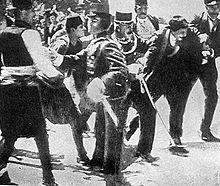 Gavrilo Princip, a Bosnian-Serb student, was arrested immediately after he assassinated Archduke Franz Ferdinand of Austria
Gavrilo Princip, a Bosnian-Serb student, was arrested immediately after he assassinated Archduke Franz Ferdinand of Austria
Austria-Hungary precipitated the Bosnian crisis of 1908–1909 by officially annexing the former Ottoman territory of Bosnia and Herzegovina, which it had occupied since 1878. This angered the Kingdom of Serbia and its patron, the Pan-Slavic and Orthodox Russian Empire.[25] Russian political manoeuvring in the region destabilised peace accords that were already fracturing in what was known as "the powder keg of Europe".[25]
In 1912 and 1913 the First Balkan War was fought between the Balkan League and the fracturing Ottoman Empire. The resulting Treaty of London further shrank the Ottoman Empire, creating an independent Albanian State while enlarging the territorial holdings of Bulgaria, Serbia, Montenegro, and Greece. When Bulgaria attacked both Serbia and Greece on 16 June 1913, it lost most of Macedonia to Serbia and Greece and Southern Dobruja to Romania in the 33-day Second Balkan War, further destabilising the region.[26]
On 28 June 1914, Gavrilo Princip, a Bosnian-Serb student and member of Young Bosnia, assassinated the heir to the Austro-Hungarian throne, Archduke Franz Ferdinand of Austria in Sarajevo, Bosnia.[27] This began a period of diplomatic manoeuvring among Austria-Hungary, Germany, Russia, France, and Britain called the July Crisis. Wanting to finally end Serbian interference in Bosnia, Austria-Hungary delivered the July Ultimatum to Serbia, a series of ten demands intentionally made unacceptable, intending to provoke a war with Serbia.[28] When Serbia agreed to only eight of the ten demands, Austria-Hungary declared war on 28 July 1914. Strachan argues, "Whether an equivocal and early response by Serbia would have made any difference to Austria-Hungary's behaviour must be doubtful. Franz Ferdinand was not the sort of personality who commanded popularity, and his demise did not cast the empire into deepest mourning".[29]
The Russian Empire, unwilling to allow Austria–Hungary to eliminate its influence in the Balkans, and in support of its longtime Serb protégés, ordered a partial mobilisation one day later.[21] When the German Empire began to mobilise on 30 July 1914, France, resentful of the German conquest of Alsace-Lorraine during the Franco-Prussian War, ordered French mobilisation on 1 August. Germany declared war on Russia on the same day.[30] The United Kingdom declared war on Germany on 4 August 1914, following an "unsatisfactory reply" to the British ultimatum that Belgium must be kept neutral.[31]
Theaters of Conflict
Opening hostilities
Confusion among the Central Powers
The strategy of the Central Powers suffered from miscommunication. Germany had promised to support Austria-Hungary's invasion of Serbia, but interpretations of what this meant differed. Previously-tested deployment plans had been replaced early in 1914, but the replacements had never been tested in exercises. Austro-Hungarian leaders believed Germany would cover its northern flank against Russia.[32] Germany, however, envisioned Austria-Hungary directing most of its troops against Russia, while Germany dealt with France. This confusion forced the Austro-Hungarian Army to divide its forces between the Russian and Serbian fronts.
On 9 September 1914, the Septemberprogramm, a possible plan which detailed Germany's specific war aims and the conditions that Germany sought to force on the Allied Powers, was outlined by German Chancellor Theobald von Bethmann-Hollweg. It was never officially adopted.
African campaigns
Main article: African theatre of World War ISome of the first clashes of the war involved British, French, and German colonial forces in Africa. On 7 August, French and British troops invaded the German protectorate of Togoland. On 10 August, German forces in South-West Africa attacked South Africa; sporadic and fierce fighting continued for the rest of the war. The German colonial forces in German East Africa, led by Colonel Paul Emil von Lettow-Vorbeck, fought a guerrilla warfare campaign during World War I and only surrendered two weeks after the armistice took effect in Europe.[33]
Serbian campaign
Main article: Serbian Campaign (World War I)The Serbian army fought the Battle of Cer against the invading Austro-Hungarians, beginning on 12 August, occupying defensive positions on the south side of the Drina and Sava rivers. Over the next two weeks Austrian attacks were thrown back with heavy losses, which marked the first major Allied victory of the war and dashed Austro-Hungarian hopes of a swift victory. As a result, Austria had to keep sizeable forces on the Serbian front, weakening its efforts against Russia.[34]
German forces in Belgium and France
Main article: Western Front (World War I)At the outbreak of the First World War, the German army (consisting in the West of seven field armies) carried out a modified version of the Schlieffen Plan, designed to quickly attack France through neutral Belgium before turning southwards to encircle the French army on the German border.[9] The plan called for the right flank of the German advance to converge on Paris, and initially the Germans were successful, particularly in the Battle of the Frontiers (14–24 August). By 12 September, the French, with assistance from the British forces, halted the German advance east of Paris at the First Battle of the Marne (5–12 September). The last days of this battle signified the end of mobile warfare in the west.[9] The French offensive into Germany, launched on 7 August with the Battle of Mulhouse, had limited success.
In the east, only one field army defended East Prussia, and when Russia attacked in this region it diverted German forces intended for the Western Front. Germany defeated Russia in a series of battles collectively known as the First Battle of Tannenberg (17 August – 2 September), but this diversion aggravated problems of insufficient speed of advance from rail-heads not foreseen by the German General Staff. The Central Powers were denied a quick victory and forced to fight a war on two fronts. The German army had fought its way into a good defensive position inside France and had permanently incapacitated 230,000 more French and British troops than it had lost itself. Despite this, communications problems and questionable command decisions cost Germany the chance of early victory.[35]
Asia and the Pacific
Main article: Asian and Pacific theatre of World War INew Zealand occupied German Samoa (later Western Samoa) on 30 August. On 11 September, the Australian Naval and Military Expeditionary Force landed on the island of Neu Pommern (later New Britain), which formed part of German New Guinea. Japan seized Germany's Micronesian colonies and, after the Siege of Tsingtao, the German coaling port of Qingdao in the Chinese Shandong peninsula. Within a few months, the Allied forces had seized all the German territories in the Pacific; only isolated commerce raiders and a few holdouts in New Guinea remained.[36][37]
Early stages
Trench warfare begins
Main article: Western Front (World War I)Military tactics before World War I had failed to keep pace with advances in technology. These advances allowed for impressive defence systems, which out-of-date military tactics could not break through for most of the war. Barbed wire was a significant hindrance to massed infantry advances. Artillery, vastly more lethal than in the 1870s, coupled with machine guns, made crossing open ground extremely difficult.[38] The Germans introduced poison gas; it soon became used by both sides, though it never proved decisive in winning a battle. Its effects were brutal, causing slow and painful death, and poison gas became one of the most-feared and best-remembered horrors of the war. Commanders on both sides failed to develop tactics for breaching entrenched positions without heavy casualties.
In time, however, technology began to produce new offensive weapons, such as the tank.[39] Britain and France were its primary users; the Germans employed captured Allied tanks and small numbers of their own design. After the First Battle of the Marne, both Entente and German forces began a series of outflanking manoeuvres, in the so-called "Race to the Sea". Britain and France soon found themselves facing entrenched German forces from Lorraine to Belgium's coast.[9] Britain and France sought to take the offensive, while Germany defended the occupied territories; consequently, German trenches were much better constructed than those of their enemy. Anglo-French trenches were only intended to be "temporary" before their forces broke through German defences.[40] Both sides tried to break the stalemate using scientific and technological advances. On 22 April 1915 at the Second Battle of Ypres, the Germans (violating the Hague Convention) used chlorine gas for the first time on the Western Front. Algerian troops retreated when gassed and a six-kilometre (four-mile) hole opened in the Allied lines that the Germans quickly exploited, taking Kitcheners' Wood. Canadian soldiers closed the breach at the Second Battle of Ypres.[41] At the Third Battle of Ypres, Canadian and ANZAC troops took the village of Passchendaele.
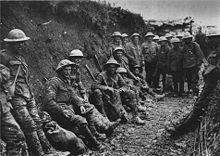 In the trenches: Royal Irish Rifles in a communications trench on the first day on the Somme, 1 July 1916.
In the trenches: Royal Irish Rifles in a communications trench on the first day on the Somme, 1 July 1916.
On 1 July 1916, the British Army endured the bloodiest day in its history, suffering 57,470 casualties, including 19,240 dead, on the first day of the Battle of the Somme. Most of the casualties occurred in the first hour of the attack. The entire Somme offensive cost the British Army almost half a million men.[42]
Neither side proved able to deliver a decisive blow for the next two years, though protracted German action at Verdun throughout 1916,[43] combined with the bloodletting at the Somme, brought the exhausted French army to the brink of collapse. Futile attempts at frontal assault came at a high price for both the British and the French poilu (infantry) and led to widespread mutinies, especially during the Nivelle Offensive.[44]
Throughout 1915–17, the British Empire and France suffered more casualties than Germany, because of both the strategic and tactical stances chosen by the sides. Strategically, while the Germans only mounted a single main offensive at Verdun, the Allies made several attempts to break through German lines. Tactically, German commander Erich Ludendorff's doctrine of "elastic defence" was well suited for trench warfare. This defence had a lightly defended forward position and a more powerful main position farther back beyond artillery range, from which an immediate and powerful counter-offensive could be launched.[45][46]
Ludendorff wrote on the fighting in 1917,
The 25th of August concluded the second phase of the Flanders battle. It had cost us heavily ... The costly August battles in Flanders and at Verdun imposed a heavy strain on the Western troops. In spite of all the concrete protection they seemed more or less powerless under the enormous weight of the enemy’s artillery. At some points they no longer displayed the firmness which I, in common with the local commanders, had hoped for. The enemy managed to adapt himself to our method of employing counter attacks ... I myself was being put to a terrible strain. The state of affairs in the West appeared to prevent the execution of our plans elsewhere. Our wastage had been so high as to cause grave misgivings, and had exceeded all expectation.[47]On the battle of the Menin Road Ridge, Ludendorff wrote,
Another terrific assault was made on our lines on the 20 September ... The enemy’s onslaught on the 20th was successful, which proved the superiority of the attack over the defence. Its strength did not consist in the tanks; we found them inconvenient, but put them out of action all the same. The power of the attack lay in the artillery, and in the fact that ours did not do enough damage to the hostile infantry as they were assembling, and above all, at the actual time of the assault.[48]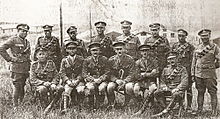 Officers and senior enlisted men of the Bermuda Militia Artillery's Bermuda Contingent, Royal Garrison Artillery, in Europe.
Officers and senior enlisted men of the Bermuda Militia Artillery's Bermuda Contingent, Royal Garrison Artillery, in Europe.
Around 1.1 to 1.2 million soldiers from the British and Dominion armies were on the Western Front at any one time.[49] A thousand battalions, occupying sectors of the line from the North Sea to the Orne River, operated on a month-long four-stage rotation system, unless an offensive was underway. The front contained over 9,600 kilometres (5,965 mi) of trenches. Each battalion held its sector for about a week before moving back to support lines and then further back to the reserve lines before a week out-of-line, often in the Poperinge or Amiens areas.
In the 1917 Battle of Arras, the only significant British military success was the capture of Vimy Ridge by the Canadian Corps under Sir Arthur Currie and Julian Byng. The assaulting troops could, for the first time, overrun, rapidly reinforce and hold the ridge defending the coal-rich Douai plain.[50][51]
Main article: Naval warfare of World War IAt the start of the war, the German Empire had cruisers scattered across the globe, some of which were subsequently used to attack Allied merchant shipping. The British Royal Navy systematically hunted them down, though not without some embarrassment from its inability to protect Allied shipping. For example, the German detached light cruiser SMS Emden, part of the East-Asia squadron stationed at Tsingtao, seized or destroyed 15 merchantmen, as well as sinking a Russian cruiser and a French destroyer. However, most of the German East-Asia squadron—consisting of the armoured cruisers Scharnhorst and Gneisenau, light cruisers Nürnberg and Leipzig and two transport ships—did not have orders to raid shipping and was instead underway to Germany when it met British warships. The German flotilla and Dresden sank two armoured cruisers at the Battle of Coronel, but was almost destroyed at the Battle of the Falkland Islands in December 1914, with only Dresden and a few auxiliaries escaping, but at the Battle of Más a Tierra these too were destroyed or interned.[52]
 A battleship squadron of the Hochseeflotte at sea
A battleship squadron of the Hochseeflotte at sea
Soon after the outbreak of hostilities, Britain began a naval blockade of Germany. The strategy proved effective, cutting off vital military and civilian supplies, although this blockade violated accepted international law codified by several international agreements of the past two centuries.[53] Britain mined international waters to prevent any ships from entering entire sections of ocean, causing danger to even neutral ships.[54] Since there was limited response to this tactic, Germany expected a similar response to its unrestricted submarine warfare.[55]
The 1916 Battle of Jutland (German: Skagerrakschlacht, or "Battle of the Skagerrak") developed into the largest naval battle of the war, the only full-scale clash of battleships during the war, and one of the largest in history. It took place on 31 May – 1 June 1916, in the North Sea off Jutland. The Kaiserliche Marine's High Seas Fleet, commanded by Vice Admiral Reinhard Scheer, squared off against the Royal Navy's Grand Fleet, led by Admiral Sir John Jellicoe. The engagement was a stand off, as the Germans, outmanoeuvred by the larger British fleet, managed to escape and inflicted more damage to the British fleet than they received. Strategically, however, the British asserted their control of the sea, and the bulk of the German surface fleet remained confined to port for the duration of the war.[56]
German U-boats attempted to cut the supply lines between North America and Britain.[57] The nature of submarine warfare meant that attacks often came without warning, giving the crews of the merchant ships little hope of survival.[57][58] The United States launched a protest, and Germany changed its rules of engagement. After the notorious sinking of the passenger ship RMS Lusitania in 1915, Germany promised not to target passenger liners, while Britain armed its merchant ships, placing them beyond the protection of the "cruiser rules" which demanded warning and placing crews in "a place of safety" (a standard which lifeboats did not meet).[59] Finally, in early 1917 Germany adopted a policy of unrestricted submarine warfare, realising the Americans would eventually enter the war.[57][60] Germany sought to strangle Allied sea lanes before the U.S. could transport a large army overseas, but could maintain only five long-range U-boats on station, to limited effect.[57]
The U-boat threat lessened in 1917, when merchant ships began travelling in convoys, escorted by destroyers. This tactic made it difficult for U-boats to find targets, which significantly lessened losses; after the hydrophone and depth charges were introduced, accompanying destroyers might attack a submerged submarine with some hope of success. Convoys slowed the flow of supplies, since ships had to wait as convoys were assembled. The solution to the delays was an extensive program to build new freighters. Troopships were too fast for the submarines and did not travel the North Atlantic in convoys.[61] The U-boats had sunk more than 5,000 Allied ships, at a cost of 199 submarines.[62]
World War I also saw the first use of aircraft carriers in combat, with HMS Furious launching Sopwith Camels in a successful raid against the Zeppelin hangars at Tondern in July 1918, as well as blimps for antisubmarine patrol.[63]
Southern theatres
War in the Balkans
Main articles: Balkans Campaign (World War I), Serbian Campaign (World War I), and Macedonian front (World War I)Austrian troops executing captured Serbians in 1917. Serbia lost about 850,000 people, a quarter of its pre-war population, and half its pre-war resources.[64]
Faced with Russia, Austria-Hungary could spare only one-third of its army to attack Serbia. After suffering heavy losses, the Austrians briefly occupied the Serbian capital, Belgrade. A Serbian counter attack in the battle of Kolubara, however, succeeded in driving them from the country by the end of 1914. For the first ten months of 1915, Austria-Hungary used most of its military reserves to fight Italy. German and Austro-Hungarian diplomats, however, scored a coup by persuading Bulgaria to join in attacking Serbia. The Austro-Hungarian provinces of Slovenia, Croatia and Bosnia provided troops for Austria-Hungary, invading Serbia as well as fighting Russia and Italy. Montenegro allied itself with Serbia.[65]
Serbia was conquered in a little more than a month. The attack began in October, when the Central Powers launched an offensive from the north; four days later the Bulgarians joined the attack from the east. The Serbian army, fighting on two fronts and facing certain defeat, retreated into Albania, halting only once to make a stand against the Bulgarians. The Serbs suffered defeat near modern day Gnjilane in the Battle of Kosovo. Montenegro covered the Serbian retreat towards the Adriatic coast in the Battle of Mojkovac in 6–7 January 1916, but ultimately the Austrians conquered Montenegro, too. Serbian forces were evacuated by ship to Greece.[66]
In late 1915, a Franco-British force landed at Salonica in Greece, to offer assistance and to pressure the government to declare war against the Central Powers. Unfortunately for the Allies, the pro-German King Constantine I dismissed the pro-Allied government of Eleftherios Venizelos, before the Allied expeditionary force could arrive.[67] The friction between the king of Greece and the Allies continued to accumulate with the National Schism, which effectively divided Greece between regions still loyal to the king and the new provisional government of Venizelos in Salonica. After intensive diplomatic negotiations and an armed confrontation in Athens between Allied and royalist forces (an incident known as Noemvriana) the king of Greece resigned, and his second son Alexander took his place. Venizelos returned to Athens on 29 May 1917 and Greece, now unified, officially joined the war on the side of the Allies. The entire Greek army was mobilized and began to participate in military operations against the Central Powers on the Macedonian front.
After conquest, Serbia was divided between Austro-Hungary and Bulgaria. In 1917 the Serbs launched the Toplica Uprising and liberated for a short time the area between the Kopaonik mountains and the South Morava river. The uprising was crushed by joint efforts of Bulgarian and Austrian forces at the end of March 1917.
The Macedonian Front was mostly static. French and Serbian forces retook limited areas of Macedonia by recapturing Bitola on 19 November 1916 as a result of the costly Monastir Offensive which brought stabilization of the front. Only at the end of the conflict did the Entente powers break through, after most of the German and Austro-Hungarian troops had withdrawn. The Bulgarians suffered their only defeat of the war at the Battle of Dobro Pole but days later, they decisively defeated British and Greek forces at the Battle of Doiran, avoiding occupation. Bulgaria signed an armistice on 29 September 1918.[68] Hindenburg and Ludendorff concluded that the strategic and operational balance had now shifted decidedly against the Central Powers and a day after the Bulgarian collapse, during a meeting with government officials, insisted on an immediate peace settlement.[69]
The disappearance of the Macedonian front meant that the road to Budapest and Vienna was now opened for the 670,000-strong army of general Franchet d'Esperey as the Bulgarian surrender deprived the Central Powers of the 278 infantry battalions and 1,500 guns (the equivalent of some 25 to 30 German divisions) that were previously holding the line.[70] The German high command responded by sending only seven infantry and one cavalry division but these forces were far from enough for a front to be reestablished.[70]
Ottoman Empire
Main article: Middle Eastern theatre of World War IThe Ottoman Empire joined the Central Powers in the war, the secret Ottoman-German Alliance having been signed in August 1914.[71] It threatened Russia's Caucasian territories and Britain's communications with India via the Suez Canal. The British and French opened overseas fronts with the Gallipoli (1915) and Mesopotamian campaigns. In Gallipoli, the Ottoman Empire successfully repelled the British, French, and Australian and New Zealand Army Corps (ANZACs). In Mesopotamia, by contrast, after the disastrous Siege of Kut (1915–16), British Imperial forces reorganised and captured Baghdad in March 1917.
Further to the west, the Suez Canal was successfully defended from Ottoman attacks in 1915 and 1916; in August a joint German and Ottoman force was defeated at the Battle of Romani. Following this victory, a British Empire force advanced across the Sinai Peninsula, pushing Ottoman forces back in the Battle of Magdhaba in December and the Battle of Rafa on the border between the Egyptian Sinai and Ottoman Palestine in January 1917. In March and April at the First and Second Battles of Gaza, German and Ottoman forces stopped the advance, but at the end of October the Sinai and Palestine Campaign resumed, when Allenby's Egyptian Expeditionary Force won the Battle of Beersheba. Two Ottoman armies were defeated a few weeks later at the Battle of Mughar Ridge, and early in December Jerusalem was captured following another Ottoman defeat at the Battle of Jerusalem (1917). About this time Friedrich Freiherr Kress von Kressenstein was relieved of his duties as the Eighth Army's commander, replaced by Djevad Pasha, and a few months later the commander of the Ottoman Army in Palestine, Erich von Falkenhayn, was replaced by Otto Liman von Sanders.
The Egyptian Expeditionary Force, under Field Marshal Edmund Allenby, broke the Ottoman forces at the Battle of Megiddo in September 1918. In six weeks, during virtually continuous operations, battles were successfully fought by British infantry and Australian, New Zealand, and British Light Horse, Mounted Rifle and Yeomanry mounted brigades. They campaigned across the Jordan River to Amman in the east and northwards to capture Nablus and Tulkarm in the Judean Hills, and followed the Mediterranean coast into the Jezreel Valley (Esdraelon Plain), where Jenin and Nazareth were captured, along with Daraa on the Hejaz railway, Semakh and Tiberias on the Sea of Gallilee, and finally Damascus and Aleppo. The Armistice of Mudros was signed on 30 October, when two and a half Ottoman armies had been defeated and captured.
Russian armies generally had the best of it in the Caucasus. Enver Pasha, supreme commander of the Ottoman armed forces, was ambitious and dreamed of re-conquering central Asia and areas that had been lost to Russia previously. He was, however, a poor commander.[72] He launched an offensive against the Russians in the Caucasus in December 1914 with 100,000 troops; insisting on a frontal attack against mountainous Russian positions in winter, he lost 86% of his force at the Battle of Sarikamish.[73]
General Yudenich, the Russian commander from 1915 to 1916, drove the Turks out of most of the southern Caucasus with a string of victories.[73] In 1917, Russian Grand Duke Nicholas assumed command of the Caucasus front. Nicholas planned a railway from Russian Georgia to the conquered territories, so that fresh supplies could be brought up for a new offensive in 1917. However, in March 1917 (February in the pre-revolutionary Russian calendar), the Czar was overthrown in the February Revolution and the Russian Caucasus Army began to fall apart.
 German soldiers in Jerusalem
German soldiers in Jerusalem
The army corps of Armenian volunteer units realigned under the command of General Tovmas Nazarbekian, with Dro as a civilian commissioner of the Administration for Western Armenia. The front line had three main divisions, commanded by Movses Silikyan, Andranik, and Mikhail Areshian. Another regular unit was under Colonel Korganian. More than 40,000 men in Armenian partisan guerrilla detachments accompanied the main units.[74]
Instigated by the Arab bureau of the British Foreign and Commonwealth Office, the Arab Revolt started with the help of Britain in June 1916 at the Battle of Mecca, led by Sherif Hussein of Mecca, and ended with the Ottoman surrender of Damascus. Fakhri Pasha, the Ottoman commander of Medina, resisted for more than two and half years during the Siege of Medina.[75]
Along the border of Italian Libya and British Egypt, the Senussi tribe, incited and armed by the Turks, waged a small-scale guerrilla war against Allied troops. The British were forced to dispatch 12,000 troops to oppose them in the Senussi Campaign. Their rebellion was finally crushed in mid-1916.[76]
Italian participation
Main article: Italian Campaign (World War I)Further information: Battles of the IsonzoItaly had been allied with the German and Austro-Hungarian Empires since 1882 as part of the Triple Alliance. However, the nation had its own designs on Austrian territory in Trentino, Istria, and Dalmatia. Rome had a secret 1902 pact with France, effectively nullifying its alliance.[77] At the start of hostilities, Italy refused to commit troops, arguing that the Triple Alliance was defensive and that Austria–Hungary was an aggressor. The Austro-Hungarian government began negotiations to secure Italian neutrality, offering the French colony of Tunisia in return. The Allies made a counter-offer in which Italy would receive the Southern Tyrol, Julian March and territory on the Dalmatian coast after the defeat of Austria-Hungary. This was formalised by the Treaty of London. Further encouraged by the Allied invasion of Turkey in April 1915, Italy joined the Triple Entente and declared war on Austria-Hungary on 23 May. Fifteen months later Italy declared war on Germany.
Militarily, the Italians had numerical superiority. This advantage, however, was lost, not only because of the difficult terrain in which fighting took place, but also because of the strategies and tactics employed. Field Marshal Luigi Cadorna, a staunch proponent of the frontal assault, had dreams of breaking into the Slovenian plateau, taking Ljubljana and threatening Vienna. It was a Napoleonic plan, which had no realistic chance of success in an age of barbed wire, machine guns, and indirect artillery fire, combined with hilly and mountainous terrain.
Depiction of the Battle of Doberdò, fought in August 1916 between the Italian and Austro-Hungarian army.
On the Trentino front, the Austro-Hungarians took advantage of the mountainous terrain, which favoured the defender. After an initial strategic retreat, the front remained largely unchanged, while Austrian Kaiserschützen and Standschützen engaged Italian Alpini in bitter hand-to-hand combat throughout the summer. The Austro-Hungarians counterattacked in the Altopiano of Asiago, towards Verona and Padua, in the spring of 1916 (Strafexpedition), but made little progress.
Beginning in 1915, the Italians under Cadorna mounted eleven offensives on the Isonzo front along the Isonzo River, northeast of Trieste. All eleven offensives were repelled by the Austro-Hungarians, who held the higher ground. In the summer of 1916, the Italians captured the town of Gorizia. After this minor victory, the front remained static for over a year, despite several Italian offensives. In the autumn of 1917, thanks to the improving situation on the Eastern front, the Austro-Hungarian troops received large numbers of reinforcements, including German Stormtroopers and the elite Alpenkorps. The Central Powers launched a crushing offensive on 26 October 1917, spearheaded by the Germans. They achieved a victory at Caporetto. The Italian Army was routed and retreated more than 100 kilometres (62 mi) to reorganise, stabilising the front at the Piave River. Since in the Battle of Caporetto the Italian Army had heavy losses, the Italian Government called to arms the so-called '99 Boys (Ragazzi del '99): that is, all males who were 18 years old. In 1918, the Austro-Hungarians failed to break through, in a series of battles on the Piave River, and were finally decisively defeated in the Battle of Vittorio Veneto in October of that year. Austria-Hungary surrendered in early November 1918.[78][79]
Romanian participation
Main article: Romania during World War IRomania had been allied with the Central Powers since 1882. When the war began, however, it declared its neutrality, arguing that because Austria-Hungary had itself declared war on Serbia, Romania was under no obligation to join the war. When the Entente Powers promised Romania large territories of eastern Hungary (Transylvania and Banat) that had a large Romanian population in exchange for Romania’s declaring war on the Central Powers, the Romanian government renounced its neutrality, and on 27 August 1916 the Romanian Army launched an attack against Austria-Hungary, with limited Russian support. The Romanian offensive was initially successful, pushing back the Austro-Hungarian troops in Transylvania, but a counterattack by the forces of the Central Powers drove back the Russo-Romanian forces. As a result of the Battle of Bucharest the Central Powers occupied Bucharest on 6 December 1916. Fighting in Moldova continued in 1917, resulting in a costly stalemate for the Central Powers.[80][81] As Russia withdrew from the war in late 1917 as a result of the October Revolution, and Romania was forced to sign an armistice with the Central Powers on 9 December 1917.
In January 1918, Romanian forces established control over Bessarabia as the Russian Army abandoned the province. Although a treaty was signed by the Romanian and the Bolshevik Russian government following talks from 5–9 March 1918 on the withdrawal of Romanian forces from Bessarabia within two months, on 27 March 1918 Romania attached Bessarabia to its territory, formally based on a resolution passed by the local assembly of the territory on the unification with Romania.
Romania officially made peace with the Central Powers by signing the Treaty of Bucharest on 7 May 1918. Under that treaty, Romania was obliged to end war with the Central Powers and make small territorial concessions to Austria-Hungary, ceding control of some passes in the Carpathian Mountains, and grant oil concessions to Germany. In exchange, the Central Powers recognised the sovereignty of Romania over Bessarabia. The treaty was renounced in October 1918 by the Alexandru Marghiloman government, and Romania nominally re-entered the war on 10 November 1918. The next day, the Treaty of Bucharest was nullified by the terms of the Armistice of Compiègne.[82][83] Total Romanian deaths from 1914 to 1918, military and civilian, within contemporary borders, were estimated at 748,000.[84]
The role of India
Further information: Third Anglo-Afghan War and Hindu-German ConspiracyThe war began with an unprecedented outpouring of loyalty and good will towards the United Kingdom from within the mainstream political leadership, contrary to initial British fears of an Indian revolt.[85][86] The Indian Army in fact outnumbered the British Army at the beginning of the war. India under British rule contributed greatly to the British war effort by providing men and resources. This was done by the Indian Congress in hope of achieving self-government, as India was very much under the control of the British. The United Kingdom disappointed the Indians by not providing self-governance, leading to the Gandhian Era in Indian history. About 1.3 million Indian soldiers and labourers served in Europe, Africa, and the Middle East, while both the Indian government and the princes sent large supplies of food, money, and ammunition. In all, 140,000 men served on the Western Front and nearly 700,000 in the Middle East. Casualties of Indian soldiers totalled 47,746 killed and 65,126 wounded during World War I.[87]
Eastern Front
Initial actions
Main article: Eastern Front (World War I)While the Western Front had reached stalemate, the war continued in East Europe. Initial Russian plans called for simultaneous invasions of Austrian Galicia and German East Prussia. Although Russia's initial advance into Galicia was largely successful, it was driven back from East Prussia by Hindenburg and Ludendorff at Tannenberg and the Masurian Lakes in August and September 1914.[88][89] Russia's less developed industrial base and ineffective military leadership was instrumental in the events that unfolded. By the spring of 1915, the Russians had retreated into Galicia, and in May the Central Powers achieved a remarkable breakthrough on Poland's southern frontiers.[90] On 5 August they captured Warsaw and forced the Russians to withdraw from Poland.
Russian Revolution
Main article: Russian Revolution (1917)Further information: North Russia CampaignDespite the success of the June 1916 Brusilov Offensive in eastern Galicia,[91] dissatisfaction with the Russian government's conduct of the war grew. The offensive's success was undermined by the reluctance of other generals to commit their forces to support the victory. Allied and Russian forces were revived only temporarily by Romania's entry into the war on 27 August. German forces came to the aid of embattled Austro-Hungarian units in Transylvania, and Bucharest fell to the Central Powers on 6 December. Meanwhile, unrest grew in Russia, as the Tsar remained at the front. Empress Alexandra's increasingly incompetent rule drew protests and resulted in the murder of her favourite, Rasputin, at the end of 1916.
In March 1917, demonstrations in Petrograd culminated in the abdication of Tsar Nicholas II and the appointment of a weak Provisional Government which shared power with the Petrograd Soviet socialists. This arrangement led to confusion and chaos both at the front and at home. The army became increasingly ineffective.[90]
 Russian Cossacks on the front, 1915
Russian Cossacks on the front, 1915
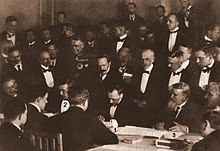 Signing the Treaty of Brest-Litovsk (February 9, 1918) are: 1. Count Ottokar von Czernin, 2. Richard von Kühlmann, and 3. Vasil Radoslavov
Signing the Treaty of Brest-Litovsk (February 9, 1918) are: 1. Count Ottokar von Czernin, 2. Richard von Kühlmann, and 3. Vasil Radoslavov
The war and the government became increasingly unpopular. Discontent led to a rise in popularity of the Bolshevik Party, led by Vladimir Lenin. He promised to pull Russia out of the war and was able to gain power. The triumph of the Bolsheviks in November was followed in December by an armistice and negotiations with Germany. At first the Bolsheviks refused the German terms, but when Germany resumed the war and marched across Ukraine with impunity, the new government acceded to the Treaty of Brest-Litovsk on 3 March 1918. It took Russia out of the war and ceded vast territories, including Finland, the Baltic provinces, parts of Poland and Ukraine to the Central Powers.[92] The manpower required for German occupation of former Russian territory may have contributed to the failure of the Spring Offensive, however, and secured relatively little food or other materiel.
With the adoption of the Treaty of Brest-Litovsk, the Entente no longer existed. The Allied powers led a small-scale invasion of Russia, partly to stop Germany from exploiting Russian resources and, to a lesser extent, to support the "Whites" (as opposed to the "Reds") in the Russian Civil War.[93] Allied troops landed in Archangel and in Vladivostok.
Central Powers proposal for starting peace negotiations
In December 1916, after ten brutal months of the Battle of Verdun and a successful offensive against Romania, the Germans attempted to negotiate a peace with the Allies. Soon after, U.S. President Woodrow Wilson attempted to intervene as a peacemaker, asking in a note for both sides to state their demands. Lloyd George's War Cabinet considered the German offer to be a ploy to create divisions amongst the Allies. After initial outrage and much deliberation, they took Wilson's note as a separate effort, signalling that the U.S. was on the verge of entering the war against Germany following the "submarine outrages". While the Allies debated a response to Wilson's offer, the Germans chose to rebuff it in favour of "a direct exchange of views". Learning of the German response, the Allied governments were free to make clear demands in their response of 14 January. They sought restoration of damages, the evacuation of occupied territories, reparations for France, Russia and Romania, and a recognition of the principle of nationalities. This included the liberation of Italians, Slavs, Romanians, Czecho-Slovaks, and the creation of a "free and united Poland". On the question of security, the Allies sought guarantees that would prevent or limit future wars, complete with sanctions, as a condition of any peace settlement.[94] The negotiations failed and the Entente powers rejected the German offer, because Germany did not state any specific proposals. To Wilson, the Entente powers stated that they would not start peace negotiations until the Central powers evacuated all occupied Allied territories and provided indemnities for all damage which had been done.[95]
1917–1918
French troopers under General Gouraud, with their machine guns amongst the ruins of a cathedral near the Marne, driving back the Germans. 1918
Developments in 1917
Events of 1917 proved decisive in ending the war, although their effects were not fully felt until 1918.
The British naval blockade began to have a serious impact on Germany. In response, in February 1917, the German General Staff convinced Chancellor Theobald von Bethmann-Hollweg to declare unrestricted submarine warfare, with the goal of starving Britain out of the war. German planners estimated that unrestricted submarine warfare would cost Britain a monthly shipping loss of 600,000 tons. While it was realised that the policy was also likely to bring the United States into the conflict, British shipping losses would be so high that it would be forced to sue for peace after 5 to 6 months, before American intervention could make an impact. In reality, tonnage sunk rose above 500,000 tons per month from February to July. It peaked at 860,000 tons in April. After July, the newly re-introduced convoy system became extremely effective in reducing the U-boat threat. Britain was safe from starvation while German industrial output fell, and the United States troops joined the war in large numbers far earlier than Germany had anticipated.
On 3 May 1917, during the Nivelle Offensive, the weary French 2nd Colonial Division, veterans of the Battle of Verdun, refused their orders, arriving drunk and without their weapons. Their officers lacked the means to punish an entire division, and harsh measures were not immediately implemented. Then, mutinies afflicted an additional 54 French divisions and saw 20,000 men desert. The other Allied forces attacked but sustained tremendous casualties.[96] However, appeals to patriotism and duty, as well as mass arrests and trials, encouraged the soldiers to return to defend their trenches, although the French soldiers refused to participate in further offensive action.[97] Robert Nivelle was removed from command by 15 May, replaced by General Philippe Pétain, who suspended bloody large-scale attacks.
 Haut-Rhin, France, 1917
Haut-Rhin, France, 1917
The victory of Austria–Hungary and Germany at the Battle of Caporetto led the Allies at the Rapallo Conference to form the Supreme War Council to coordinate planning. Previously, British and French armies had operated under separate commands.
In December, the Central Powers signed an armistice with Russia. This released large numbers of German troops for use in the west. With German reinforcements and new American troops pouring in, the outcome was to be decided on the Western Front. The Central Powers knew that they could not win a protracted war, but they held high hopes for success based on a final quick offensive. Furthermore, the leaders of the Central Powers and the Allies became increasingly fearful of social unrest and revolution in Europe. Thus, both sides urgently sought a decisive victory.[98]
Entry of the United States
Main article: American entry into World War INon-Intervention
At the outbreak of the war the United States pursued a policy of non-intervention, avoiding conflict while trying to broker a peace. When a German U-boat sank the British liner Lusitania in 1915, with 128 Americans aboard, U.S. President Woodrow Wilson claimed that "America is too proud to fight" but demanded an end to attacks on passenger ships. Germany complied. Wilson unsuccessfully tried to mediate a settlement. However, he also repeatedly warned that the U.S.A. would not tolerate unrestricted submarine warfare, in violation of international law and U.S. ideas of human rights. Wilson was under pressure from former president Theodore Roosevelt, who denounced German acts as "piracy".[99] Wilson's desire to have a seat at negotiations at war's end to advance the League of Nations also played a role in the eventual decision to join the war.[100] Wilson's Secretary of State, William Jennings Bryan, whose opinions had been ignored, resigned in 1915, as he could no longer support the president's policy. Public opinion was angered at suspected German sabotage of Black Tom in Jersey City, New Jersey, and the Kingsland Explosion.
In January 1917, Germany resumed unrestricted submarine warfare. The German Foreign Minister, in the Zimmermann Telegram, told Mexico that U.S. entry was likely once unrestricted submarine warfare began, and invited Mexico to join the war as Germany's ally against the United States. In return, the Germans would send Mexico money and help it recover the territories of Texas, New Mexico, and Arizona that Mexico had lost during the Mexican-American War 70 years earlier.[101] Wilson released the Zimmerman note to the public, and Americans saw it as casus belli— a cause for war.
U.S. declaration of war on Germany
After the sinking of seven U.S. merchant ships by submarines and the publication of the Zimmerman telegram, Wilson called for war on Germany,[102] which the U.S. Congress declared on 6 April 1917.
First active U.S. participation
The United States was never formally a member of the Allies but became a self-styled "Associated Power". The United States had a small army, but, after the passage of the Selective Service Act, it drafted 2.8 million men[103], and by summer 1918 was sending 10,000 fresh soldiers to France every day. In 1917, the U.S. Congress gave U.S. citizenship to Puerto Ricans when they were drafted to participate in World War I, as part of the Jones Act. Germany had miscalculated, believing it would be many more months before American soldiers would arrive and that their arrival could be stopped by U-boats.[104]
The United States Navy sent a battleship group to Scapa Flow to join with the British Grand Fleet, destroyers to Queenstown, Ireland, and submarines to help guard convoys. Several regiments of U.S. Marines were also dispatched to France. The British and French wanted U.S. units used to reinforce their troops already on the battle lines and not waste scarce shipping on bringing over supplies. The U.S. rejected the first proposition and accepted the second. General John J. Pershing, American Expeditionary Forces (AEF) commander, refused to break up U.S. units to be used as reinforcements for British Empire and French units. As an exception, he did allow African-American combat regiments to be used in French divisions. The Harlem Hellfighters fought as part of the French 16th Division, earning a unit Croix de Guerre for their actions at Chateau-Thierry, Belleau Wood, and Sechault.[105] AEF doctrine called for the use of frontal assaults, which had long since been discarded by British Empire and French commanders because of the large loss of life.[106]
Austrian offer of separate peace
In 1917, Emperor Charles I of Austria secretly attempted separate peace negotiations with Clemenceau, with his wife's brother Sixtus in Belgium as an intermediary, without the knowledge of Germany. When the negotiations failed, his attempt was revealed to Germany, resulting in a diplomatic catastrophe.[107][108]
German Spring Offensive of 1918
Main article: Spring OffensiveGerman General Erich Ludendorff drew up plans (codenamed Operation Michael) for the 1918 offensive on the Western Front. The Spring Offensive sought to divide the British and French forces with a series of feints and advances. The German leadership hoped to strike a decisive blow before significant U.S. forces arrived. The operation commenced on 21 March 1918 with an attack on British forces near Amiens. German forces achieved an unprecedented advance of 60 kilometres (37 mi).[109]
British and French trenches were penetrated using novel infiltration tactics, also named Hutier tactics, after General Oskar von Hutier. Previously, attacks had been characterised by long artillery bombardments and massed assaults. However, in the Spring Offensive of 1918, Ludendorff used artillery only briefly and infiltrated small groups of infantry at weak points. They attacked command and logistics areas and bypassed points of serious resistance. More heavily armed infantry then destroyed these isolated positions. German success relied greatly on the element of surprise.[110]
The front moved to within 120 kilometres (75 mi) of Paris. Three heavy Krupp railway guns fired 183 shells on the capital, causing many Parisians to flee. The initial offensive was so successful that Kaiser Wilhelm II declared 24 March a national holiday. Many Germans thought victory was near. After heavy fighting, however, the offensive was halted. Lacking tanks or motorised artillery, the Germans were unable to consolidate their gains. This situation was not helped by the supply lines now being stretched as a result of their advance.[111] The sudden stop was also a result of the four Australian Imperial Force (AIF) divisions that were "rushed" down, thus doing what no other army had done: stopping the German advance in its tracks. During that time the first Australian division was hurriedly sent north again to stop the second German breakthrough.
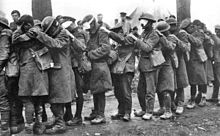 British 55th (West Lancashire) Infantry Division troops blinded by tear gas during the Battle of Estaires, 10 April 1918.
British 55th (West Lancashire) Infantry Division troops blinded by tear gas during the Battle of Estaires, 10 April 1918.
General Foch pressed to use the arriving American troops as individual replacements. Pershing sought instead to field American units as an independent force. These units were assigned to the depleted French and British Empire commands on 28 March. A Supreme War Council of Allied forces was created at the Doullens Conference on 5 November 1917.[112] General Foch was appointed as supreme commander of the allied forces. Haig, Petain, and Pershing retained tactical control of their respective armies; Foch assumed a coordinating rather than a directing role, and the British, French, and U.S. commands operated largely independently.[112]
Following Operation Michael, Germany launched Operation Georgette against the northern English Channel ports. The Allies halted the drive after limited territorial gains by Germany. The German Army to the south then conducted Operations Blücher and Yorck, pushing broadly towards Paris. Operation Marne was launched on 15 July, attempting to encircle Reims and beginning the Second Battle of the Marne. The resulting counterattack, starting the Hundred Days Offensive, marked the first successful Allied offensive of the war.
By 20 July the Germans were back across the Marne at their Kaiserschlacht starting lines,[113] having achieved nothing. Following this last phase of the war in the West, the German Army never regained the initiative. German casualties between March and April 1918 were 270,000, including many highly trained storm troopers.
Meanwhile, Germany was falling apart at home. Anti-war marches became frequent and morale in the army fell. Industrial output was 53 percent of 1913 levels.
New states under war zone
Main articles: Democratic Republic of Armenia, Azerbaijan Democratic Republic, and Democratic Republic of GeorgiaIn the late spring of 1918, three new states were formed in the South Caucasus: the Democratic Republic of Armenia, the Azerbaijan Democratic Republic, and the Democratic Republic of Georgia, which declared their independence from the Russian Empire.[114] Two other minor entities were established, the Centrocaspian Dictatorship and South West Caucasian Republic. The former was liquidated by Azerbaijan in the autumn of 1918 and the latter by a joint Armenian-British task force in early 1919.
Allied victory: summer and autumn 1918
Main articles: Hundred Days Offensive and Weimar RepublicThe Allied counteroffensive, known as the Hundred Days Offensive, began on 8 August 1918. The Battle of Amiens developed with III Corps British Fourth Army on the left, the French First Army on the right, and the Australian and Canadian Corps spearheading the offensive in the centre through Harbonnières.[115][116] It involved 414 tanks of the Mark IV and Mark V type, and 120,000 men. They advanced 12 kilometres (7.5 mi) into German-held territory in just seven hours. Erich Ludendorff referred to this day as the "Black Day of the German army".[115][117]
 Aerial view of ruins of Vaux, France, 1918
Aerial view of ruins of Vaux, France, 1918
The Australian-Canadian spearhead at Amiens, a battle that was the beginning of Germany’s downfall,[48] helped pull forward the British armies to the north and the French armies to the south. On the British Fourth Army front at Amiens, after an advance as far as 14 miles (23 km), German resistance stiffened, and the battle there concluded. But the French Third Army lengthened the Amiens front on 10 August, when it was thrown in on the right of the French First Army, and advanced 4 miles (6 km), liberating Lassigny in fighting which lasted until 16 August. South of the French Third Army, General Charles Mangin (The Butcher) drove his French Tenth Army forward at Soissons on 20 August to capture eight thousand prisoners, two hundred guns, and the Aisne heights overlooking and menacing the German position north of the Vesle.[118] Another "Black day", as described by Erich Ludendorff.
Meanwhile General Byng of the British Third Army, reporting that the enemy on his front was thinning in a limited withdrawal, was ordered to attack with 200 tanks towards Bapaume, opening the Battle of Albert, with specific orders "To break the enemy's front, in order to outflank the enemy's present battle front" (opposite the British Fourth Army at Amiens).[48] Allied leaders had now realised that to continue an attack after resistance had hardened was a waste of lives, and it was better to turn a line than to try to roll over it. They began to undertake attacks in quick order to take advantage of successful advances on the flanks, then broke them off when each attack lost its initial impetus.[118]
The British Third Army's 15-mile (24 km) front north of Albert progressed after stalling for a day against the main resistance line to which the enemy had withdrawn.[119] Rawlinson’s British Fourth Army was able to push its left flank forward between Albert and the Somme, straightening the line between the advanced positions of the Third Army and the Amiens front, which resulted in recapturing Albert at the same time.[118] On 26 August the British First Army on the left of the Third Army was drawn into the battle, extending it northward to beyond Arras. The Canadian Corps, already back in the vanguard of the First Army, fought its way from Arras eastward 5 miles (8 km) astride the heavily defended Arras-Cambrai area before reaching the outer defences of the Hindenburg Line, breaching them on the 28 and 29 August. Bapaume fell on 29 August to the New Zealand Division of the Third Army, and the Australians, still leading the advance of the Fourth Army, were again able to push forward at Amiens to take Peronne and Mont Saint-Quentin on 31 August. Further south, the French First and Third Armies had slowly fought forward while the Tenth Army, which had by now crossed the Ailette and was east of the Chemin des Dames, neared the Alberich position of the Hindenburg Line.[120] During the last week of August the pressure along a 70-mile (113 km) front against the enemy was heavy and unrelenting. From German accounts, "Each day was spent in bloody fighting against an ever and again on-storming enemy, and nights passed without sleep in retirements to new lines."[118] Even to the north in Flanders the British Second and Fifth Armies during August and September were able to make progress, taking prisoners and positions that had previously been denied them.[120]
American troops in Vladivostok, Siberia, August 1918 Close-up view of an American major in the basket of an observation balloon flying over territory near front lines
Close-up view of an American major in the basket of an observation balloon flying over territory near front lines
On 2 September the Canadian Corps outflanking of the Hindenburg line, with the breaching of the Wotan Position, made it possible for the Third Army to advance, which sent repercussions all along the Western Front. That same day Oberste Heeresleitung (OHL) had no choice but to issue orders to six armies to withdraw back into the Hindenburg Line in the south, behind the Canal du Nord on the Canadian-First Army's front and back to a line east of the Lys in the north. This ceded without a fight the salient seized the previous April.[121] According to Ludendorff “We had to admit the necessity ...to withdraw the entire front from the Scarpe to the Vesle.”[122]
In nearly four weeks of fighting beginning 8 August, over 100,000 German prisoners were taken, 75,000 by the BEF and the rest by the French. As of "The Black Day of the German Army", the German High Command realised the war was lost and made attempts to reach a satisfactory end. The day after that battle Ludenforff told Colonel Mertz: "We cannot win the war any more, but we must not lose it either." On 11 August he offered his resignation to the Kaiser, who refused it, replying, "I see that we must strike a balance. We have nearly reached the limit of our powers of resistance. The war must be ended." On 13 August at Spa, Hindenburg, Ludendorff, the Chancellor, and Foreign Minister Hintz agreed that the war could not be ended militarily, and on the following day the German Crown Council decided that victory in the field was now most improbable. Austria and Hungary warned that they could only continue the war until December, and Ludendorff recommended immediate peace negotiations, to which the Kaiser responded by instructing Hintz to seek the mediation of the Queen of the Netherlands. Prince Rupprecht warned Prince Max of Baden: "Our military situation has deteriorated so rapidly that I no longer believe we can hold out over the winter; it is even possible that a catastrophe will come earlier." On 10 September Hindenburg urged peace moves to Emperor Charles of Austria, and Germany appealed to the Netherlands for mediation. On 14 September Austria sent a note to all belligerents and neutrals suggesting a meeting for peace talks on neutral soil, and on 15 September Germany made a peace offer to Belgium. Both peace offers were rejected, and on 24 September OHL informed the leaders in Berlin that armistice talks were inevitable.[120]
September saw the Germans continuing to fight strong rear-guard actions and launching numerous counterattacks on lost positions, but only a few succeeded, and then only temporarily. Contested towns, villages, heights, and trenches in the screening positions and outposts of the Hindenburg Line continued to fall to the Allies, with the BEF alone taking 30,441 prisoners in the last week of September. Further small advances eastward would follow the Third Army's victory at Ivincourt on 12 September, the Fourth Army's at Epheny on 18 September, and the French gain of Essigny-le-Grand a day later. On 24 September a final assault by both the British and French on a 4-mile (6.4 km) front would come within 2 miles (3.2 km) of St. Quentin.[120] With the outposts and preliminary defensive lines of the Siegfried and Alberich Positions eliminated, the Germans were now completely back in the Hindenburg Line. With the Wotan position of that line already breached and the Siegfried position in danger of being turned from the north, the time had now come for an Allied assault on the whole length of the line.
The Allied attack on the Hindenburg Line, begun on 26 September, included U.S. soldiers. The still-green American troops suffered problems coping with supply trains for large units on a difficult landscape.[123] The following week cooperating French and American units broke through in Champagne at the Battle of Blanc Mont Ridge, forcing the Germans off the commanding heights, and closing towards the Belgian frontier.[124] The last Belgian town to be liberated before the armistice was Ghent, which the Germans held as a pivot until the Allies brought up artillery.[125][126] The German army had to shorten its front and use the Dutch frontier as an anchor to fight rear-guard actions.
 Men of U.S. 64th Regiment, 7th Infantry Division, celebrate the news of the Armistice, November 11, 1918
Men of U.S. 64th Regiment, 7th Infantry Division, celebrate the news of the Armistice, November 11, 1918
When Bulgaria signed a separate armistice on 29 September, the Allies gained control of Serbia and Greece. Ludendorff, having been under great stress for months, suffered something similar to a breakdown. It was evident that Germany could no longer mount a successful defence.[127][128]
Meanwhile, news of Germany's impending military defeat spread throughout the German armed forces. The threat of mutiny was rife. Admiral Reinhard Scheer and Ludendorff decided to launch a last attempt to restore the "valour" of the German Navy. Knowing the government of Prince Maximilian of Baden would veto any such action, Ludendorff decided not to inform him. Nonetheless, word of the impending assault reached sailors at Kiel. Many, refusing to be part of a naval offensive which they believed to be suicidal, rebelled and were arrested. Ludendorff took the blame; the Kaiser dismissed him on 26 October. The collapse of the Balkans meant that Germany was about to lose its main supplies of oil and food. Its reserves had been used up, even as U.S. troops kept arriving at the rate of 10,000 per day.[129]
Having suffered over 6 million casualties, Germany moved towards peace. Prince Maximilian of Baden took charge of a new government as Chancellor of Germany to negotiate with the Allies. Telegraphic negotiations with President Wilson began immediately, in the vain hope that he would offer better terms than the British and French. Instead Wilson demanded the abdication of the Kaiser. There was no resistance when the social democrat Philipp Scheidemann on 9 November declared Germany to be a republic. Imperial Germany was dead; a new Germany had been born: the Weimar Republic.[130]
Armistices and capitulations
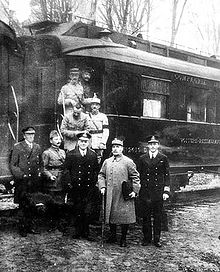 In the forest of Compiègne after agreeing to the armistice that ended the war, Foch is seen second from the right. The carriage seen in the background, where the armistice was signed, was later chosen as the symbolic setting of Pétain's June 1940 armistice. It was moved to Berlin as a prize, but because of Allied bombing was eventually moved to Crawinkel, Thuringia, where it was deliberately destroyed by SS troops in 1945.[131]
In the forest of Compiègne after agreeing to the armistice that ended the war, Foch is seen second from the right. The carriage seen in the background, where the armistice was signed, was later chosen as the symbolic setting of Pétain's June 1940 armistice. It was moved to Berlin as a prize, but because of Allied bombing was eventually moved to Crawinkel, Thuringia, where it was deliberately destroyed by SS troops in 1945.[131]
The collapse of the Central Powers came swiftly. Bulgaria was the first to sign an armistice, on 29 September 1918 at Saloniki.[132] On 30 October, the Ottoman Empire capitulated at Moudros (Armistice of Mudros).[132]
On 24 October, the Italians began a push which rapidly recovered territory lost after the Battle of Caporetto. This culminated in the Battle of Vittorio Veneto, which marked the end of the Austro-Hungarian Army as an effective fighting force. The offensive also triggered the disintegration of the Austro-Hungarian Empire. During the last week of October, declarations of independence were made in Budapest, Prague, and Zagreb. On 29 October, the imperial authorities asked Italy for an armistice. But the Italians continued advancing, reaching Trento, Udine, and Trieste. On 3 November Austria–Hungary sent a flag of truce to ask for an Armistice. The terms, arranged by telegraph with the Allied Authorities in Paris, were communicated to the Austrian commander and accepted. The Armistice with Austria was signed in the Villa Giusti, near Padua, on 3 November. Austria and Hungary signed separate armistices following the overthrow of the Habsburg Monarchy.
Following the outbreak of the German Revolution of 1918–1919, a republic was proclaimed on 9 November. The Kaiser fled to the Netherlands. On 11 November an armistice with Germany was signed in a railroad carriage at Compiègne. At 11 a.m. on 11 November 1918 — "the eleventh hour of the eleventh day of the eleventh month" — a ceasefire came into effect. Opposing armies on the Western Front began to withdraw from their positions. Canadian Private George Lawrence Price is traditionally regarded as the last soldier killed in the Great War: he was shot by a German sniper at 10:57 and died at 10:58.[133]
Allied superiority and the stab-in-the-back legend, November 1918
In November 1918 the Allies had ample supplies of men and materiel to invade Germany. Yet at the time of the armistice, no Allied force had crossed the German frontier; the Western Front was still almost 900 mi (1,400 km) from Berlin; and the Kaiser's armies had retreated from the battlefield in good order. These factors enabled Hindenburg and other senior German leaders to spread the story that their armies had not really been defeated. This resulted in the stab-in-the-back legend[134][135], which attributed Germany's defeat not to its inability to continue fighting (even though up to a million soldiers were suffering from the 1918 flu pandemic and unfit to fight), but to the public's failure to respond to its "patriotic calling" and the supposed intentional sabotage of the war effort, particularly by Jews, Socialists, and Bolsheviks.
A formal state of war between the two sides persisted for another seven months, until the signing of the Treaty of Versailles with Germany on 28 June 1919. Later treaties with Austria, Hungary, Bulgaria, and the Ottoman Empire were signed. However, the negotiation of the latter treaty with the Ottoman Empire was followed by strife (the Turkish War of Independence), and a final peace treaty between the Allied Powers and the country that would shortly become the Republic of Turkey was not signed until 24 July 1923, at Lausanne.
Some war memorials date the end of the war as being when the Versailles Treaty was signed in 1919, which was when many of the troops serving abroad finally returned to their home countries; by contrast, most commemorations of the war's end concentrate on the armistice of 11 November 1918. Legally, the formal peace treaties were not complete until the last, the Treaty of Lausanne, was signed. Under its terms, the Allied forces divested Constantinople on 23 August 1923.
Technology
See also: Technology during World War I and Weapons of World War IThe First World War began as a clash of 20th-century technology and 19th-century tactics, with the inevitably large ensuing casualties. By the end of 1917, however, the major armies, now numbering millions of men, had modernised and were making use of telephone, wireless communication,[136] armoured cars, tanks,[137], and aircraft. Infantry formations were reorganised, so that 100-man companies were no longer the main unit of manoeuvre; instead, squads of 10 or so men, under the command of a junior NCO, were favoured.
Artillery also underwent a revolution. In 1914, cannons were positioned in the front line and fired directly at their targets. By 1917, indirect fire with guns (as well as mortars and even machine guns) was commonplace, using new techniques for spotting and ranging, notably aircraft and the often overlooked field telephone. Counter-battery missions became commonplace, also, and sound detection was used to locate enemy batteries.
Germany was far ahead of the Allies in utilising heavy indirect fire. She employed 150 and 210 mm howitzers in 1914, when the typical French and British guns were only 75 and 105 mm. The British had a 6 inch (152 mm) howitzer, but it was so heavy it had to be hauled to the field in pieces and assembled. Germans also fielded Austrian 305 mm and 420 mm guns, and already by the beginning of the war had inventories of various calibers of Minenwerfer ideally suited for trench warfare.[138]
Much of the combat involved trench warfare, in which hundreds often died for each yard gained. Many of the deadliest battles in history occurred during the First World War. Such battles include Ypres, the Marne, Cambrai, the Somme, Verdun, and Gallipoli. The Germans employed the Haber process of nitrogen fixation to provide their forces with a constant supply of gunpowder, despite the British naval blockade.[139] Artillery was responsible for the largest number of casualties[140] and consumed vast quantities of explosives. The large number of head wounds caused by exploding shells and fragmentation forced the combatant nations to develop the modern steel helmet, led by the French, who introduced the Adrian helmet in 1915. It was quickly followed by the Brodie helmet, worn by British Imperial and U.S. troops, and in 1916 by the distinctive German Stahlhelm, a design, with improvements, still in use today.
"Gas! Gas! Quick, boys!... Fitting the clumsy helmets just in time; But someone still was yelling out and stumbling, And flound'ring like a man in fire or lime... Dim, through the misty panes and thick green light, As under a green sea, I saw him drowning."- Wilfred Owen, DULCE ET DECORUM EST, 1917[141] The widespread use of chemical warfare was a distinguishing feature of the conflict. Gases used included chlorine, mustard gas and phosgene. Few war casualties were caused by gas,[142] as effective countermeasures to gas attacks were quickly created, such as gas masks. The use of chemical warfare and small-scale strategic bombing were both outlawed by the 1907 Hague Conventions, and both proved to be of limited effectiveness,[143] though they captured the public imagination.[144]
The most powerful land-based weapons were railway guns weighing hundreds of tons apiece. These were nicknamed Big Berthas, even though the namesake was not a railway gun. Germany developed the Paris Gun, able to bombard Paris from over 100 kilometres (62 mi), though shells were relatively light at 94 kilograms (210 lb). While the Allies also had railway guns, German models severely out-ranged and out-classed them.
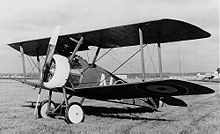 RAF Sopwith Camel. In April 1917, the average life expectancy of a British pilot on the Western Front was 93 flying hours.[145]
RAF Sopwith Camel. In April 1917, the average life expectancy of a British pilot on the Western Front was 93 flying hours.[145]
Fixed-wing aircraft were first used militarily by the Italians in Libya on 23 October 1911 during the Italo-Turkish War for reconnaissance, soon followed by the dropping of grenades and aerial photography the next year. By 1914 their military utility was obvious. They were initially used for reconnaissance and ground attack. To shoot down enemy planes, anti-aircraft guns and fighter aircraft were developed. Strategic bombers were created, principally by the Germans and British, though the former used Zeppelins as well.[146] Towards the end of the conflict, aircraft carriers were used for the first time, with HMS Furious launching Sopwith Camels in a raid to destroy the Zeppelin hangars at Tondern in 1918.[147]
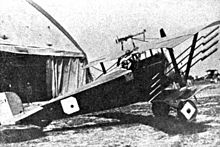 Johnson's Nieuport 16 armed with Le Prieur rockets for attacking observation balloons.
Johnson's Nieuport 16 armed with Le Prieur rockets for attacking observation balloons.
Germany deployed U-boats (submarines) after the war began. Alternating between restricted and unrestricted submarine warfare in the Atlantic, the Kaiserliche Marine employed them to deprive the British Isles of vital supplies. The deaths of British merchant sailors and the seeming invulnerability of U-boats led to the development of depth charges (1916), hydrophones (passive sonar, 1917), blimps, hunter-killer submarines (HMS R-1, 1917), forward-throwing anti-submarine weapons, and dipping hydrophones (the latter two both abandoned in 1918).[148] To extend their operations, the Germans proposed supply submarines (1916). Most of these would be forgotten in the interwar periodmdash;until World War II revived the need.
 British Vickers machine gun
British Vickers machine gun
Trenches, machine guns, air reconnaissance, barbed wire, and modern artillery with fragmentation shells helped bring the battle lines of World War I to a stalemate. The British sought a solution with the creation of the tank and mechanised warfare. The first tanks were used during the Battle of the Somme on 15 September 1916. Mechanical reliability was an issue, but the experiment proved its worth. Within a year, the British were fielding tanks by the hundreds, and they showed their potential during the Battle of Cambrai in November 1917, by breaking the Hindenburg Line, while combined arms teams captured 8000 enemy soldiers and 100 guns. The conflict also saw the introduction of Light automatic weapons and submachine guns, such as the Lewis Gun, the Browning automatic rifle, and the Bergmann MP18.
Manned observation balloons, floating high above the trenches, were used as stationary reconnaissance platforms, reporting enemy movements and directing artillery. Balloons commonly had a crew of two, equipped with parachutes.[149], so that if there was an enemy air attack the crew could parachute to safety. (At the time, parachutes were too heavy to be used by pilots of aircraft (with their marginal power output), and smaller versions were not developed until the end of the war; they were also opposed by British leadership, who feared they might promote cowardice.)[150]
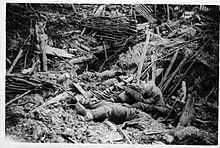 German trench destroyed by a mine explosion. Approximately 10,000 German troops were killed when the 19 mines were simultaneously detonated.
German trench destroyed by a mine explosion. Approximately 10,000 German troops were killed when the 19 mines were simultaneously detonated.
Recognised for their value as observation platforms, balloons were important targets of enemy aircraft. To defend them against air attack, they were heavily protected by antiaircraft guns and patrolled by friendly aircraft; to attack them, unusual weapons such as air-to-air rockets were even tried. Thus, the reconnaissance value of blimps and balloons contributed to the development of air-to-air combat between all types of aircraft, and to the trench stalemate, because it was impossible to move large numbers of troops undetected. The Germans conducted air raids on England during 1915 and 1916 with airships, hoping to damage British morale and cause aircraft to be diverted from the front lines, and indeed the resulting panic led to the diversion of several squadrons of fighters from France.[146][150]
Another new weapon, the flamethrower, was first used by the German army and later adopted by other forces. Although not of high tactical value, the flamethrower was a powerful, demoralising weapon that caused terror on the battlefield. It was a dangerous weapon to wield, as its heavy weight made operators vulnerable targets.
Trench railways evolved to supply the enormous quantities of food, water, and ammunition required to support large numbers of soldiers in areas where conventional transportation systems had been destroyed. Internal combustion engines and improved traction systems for automobiles and trucks/lorries eventually rendered trench railways obsolete.
War crimes
Genocide and ethnic cleansing
Ottoman Empire
Main article: Ottoman casualties of World War I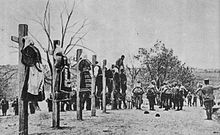 Austro-Hungarian soldiers executing Serb civilians during World War I occupation, Mačva, 1914
Austro-Hungarian soldiers executing Serb civilians during World War I occupation, Mačva, 1914
The ethnic cleansing of the Ottoman Empire's Christian population, with the most prominent among them being the deportation and massacres of Armenians (similar policies were enacted against the Assyrians and Ottoman Greeks) during the final years of the Ottoman Empire is considered genocide.[151] The Ottomans saw the entire Armenian population as an enemy[152] that had chosen to side with Russia at the beginning of the war.[153] In early 1915, a number of Armenian nationalist groups, such as the Armenakan, Dashnak, and Hunchak organisations, joined the Russian forces, and the Ottoman government used this as a pretext to issue the Tehcir Law. This authorised the deportation of the Armenians from eastern Anatolia to Syria between 1915 and 1917. The exact number of deaths is unknown: while Balakian gives a range of 250,000 to 1.5 million for the deaths of Armenians,[154] the International Association of Genocide Scholars estimates over 1 million.[151] The government of Turkey has consistently rejected charges of genocide, arguing that those who died were victims of inter-ethnic fighting, famine, or disease during the First World War.[155]
Russian Empire
Main article: Anti-Jewish pogroms in the Russian EmpireSee also: Russian occupation of Eastern Galicia, 1914-1915, Volhynia, and Volga GermansApproximately 200,000 Germans living in Volhynia and about 600,000 Jews were deported by the Russian authorities.[156][157][158] In 1916, an order was issued to deport around 650,000 Volga Germans to the east as well, but the Russian Revolution prevented this from being carried out.[159] Many pogroms accompanied the Revolution of 1917 and the ensuing Russian Civil War, 60,000–200,000 civilian Jews were killed in the atrocities throughout the former Russian Empire.[160][161]
"Rape of Belgium"
Main article: Rape of BelgiumIn Belgium, German troops, in fear of French and Belgian guerrilla fighters, or francs-tireurs, massacred townspeople in Andenne (211 dead), Tamines (384 dead), and Dinant (612 dead). On 25 August 1914, the Germans set fire to the town of Leuven, burned the library containing about 230,000 books, killed 209 civilians, and forced 42,000 to evacuate. These actions brought worldwide condemnation.[162]
Soldiers' experiences
Main articles: List of surviving veterans of World War I, World War I casualties, Commonwealth War Graves Commission, and American Battle Monuments Commission The First Contingent of the Bermuda Volunteer Rifle Corps to the 1 Lincolns, training in Bermuda for the Western Front, winter 1914–1915. One in four survived the war.
The First Contingent of the Bermuda Volunteer Rifle Corps to the 1 Lincolns, training in Bermuda for the Western Front, winter 1914–1915. One in four survived the war.
The soldiers of the war were initially volunteers, except for those of Italy, but increasingly were conscripted into service. Britain's Imperial War Museum has collected more than 2,500 recordings of soldiers' personal accounts, and selected transcripts, edited by military author Max Arthur, have been published. The Museum believes that historians have not taken full account of this material, and accordingly has made the full archive of recordings available to authors and researchers.[163] Surviving veterans, returning home, often found that they could only discuss their experiences amongst themselves. Grouping together, they formed "veterans' associations" or "Legions".
Prisoners of war
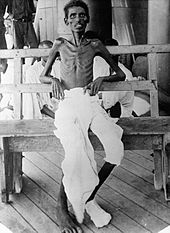 This photograph shows an emaciated Indian Army soldier who survived the Siege of Kut.
This photograph shows an emaciated Indian Army soldier who survived the Siege of Kut.
About 8 million men surrendered and were held in POW camps during the war. All nations pledged to follow the Hague Conventions on fair treatment of prisoners of war. POWs' rate of survival was generally much higher than that of their peers at the front.[164] Individual surrenders were uncommon; large units usually surrendered en masse. At the Battle of Tannenberg 92,000 Russians surrendered. When the besieged garrison of Kaunas surrendered in 1915, some 20,000 Russians became prisoners. Over half of Russian losses (as a proportion of those captured, wounded, or killed) were to prisoner status; for Austria-Hungary 32%, for Italy 26%, for France 12%, for Germany 9%; for Britain 7%. Prisoners from the Allied armies totalled about 1.4 million (not including Russia, which lost 2.-3.5[clarification needed] million men as prisoners.) From the Central Powers about 3.3 million men became prisoners.[165]
Germany held 2.5 million prisoners; Russia held 2.9 million; while Britain and France held about 720,000. Most were captured just prior to the Armistice. The U.S. held 48,000. The most dangerous moment was the act of surrender, when helpless soldiers were sometimes gunned down.[166][167] Once prisoners reached a camp, conditions were, in general, satisfactory (and much better than in World War II), thanks in part to the efforts of the International Red Cross and inspections by neutral nations. However, conditions were terrible in Russia: starvation was common for prisoners and civilians alike; about 15–20% of the prisoners in Russia died. In Germany, food was scarce, but only 5% died.[168][169][170]
 German prisoners in a French prison camp
German prisoners in a French prison camp
The Ottoman Empire often treated POWs poorly.[171] Some 11,800 British Empire soldiers, most of them Indians, became prisoners after the Siege of Kut in Mesopotamia in April 1916; 4,250 died in captivity.[172] Although many were in very bad condition when captured, Ottoman officers forced them to march 1,100 kilometres (684 mi) to Anatolia. A survivor said: "We were driven along like beasts; to drop out was to die."[173] The survivors were then forced to build a railway through the Taurus Mountains.
In Russia, when the prisoners from the Czech Legion of the Austro-Hungarian army were released in 1917, they re-armed themselves and briefly became a military and diplomatic force during the Russian Civil War.
While the Allied prisoners of the Central Powers were quickly sent home at the end of active hostilities, the same treatment was not granted to Central Power prisoners of the Allies and Russia, many of whom served as forced labor, e.g., in France until 1920. They were released only after many approaches by the Red Cross to the Allied Supreme Council.[174] German prisoners were still being held in Russia as late as 1924.[175]
Military attachés and war correspondents
Military and civilian observers from every major power closely followed the course of the war. Many were able to report on events from a perspective somewhat akin to modern "embedded" positions within the opposing land and naval forces. These military attachés and other observers prepared voluminous first-hand accounts of the war and analytical papers.
For example, former U.S. Army Captain Granville Fortescue followed the developments of the Gallipoli Campaign from an embedded perspective within the ranks of the Turkish defenders; and his report was passed through Turkish censors before being printed in London and New York.[176] However, this observer's role was abandoned when the U.S. entered the war, as Fortescue immediately re-enlisted, sustaining wounds at Forest of Argonne in the Meuse-Argonne Offensive, September 1918.[177]
In-depth observer narratives of the war and more narrowly focused professional journal articles were written soon after the war; and these post-war reports conclusively illustrated the battlefield destructiveness of this conflict. This was not the first time the tactics of entrenched positions for infantry defended with machine guns and artillery became vitally important. The Russo-Japanese War had been closely observed by military attachés, war correspondents and other observers; but, from a 21st century perspective, it is now apparent that a range of tactical lessons were disregarded or not used in the preparations for war in Europe and throughout the Great War.[178]
Support and opposition to the war
Main articles: Opposition to World War I and French Army Mutinies (1917)Support
In the Balkans, Yugoslav nationalists such as the leader Ante Trumbić in the Balkans strongly supported the war, desiring the freedom of Yugoslavs from Austria-Hungary and other foreign powers and the creation of an independent Yugoslavia.[179] The Yugoslav Committee was formed in Paris on 30 April 1915 but shortly moved its office to London; Trumbić led the Committee.[179]
In the Middle East, Arab nationalism soared in Ottoman territories in response to the rise of Turkish nationalism during the war, with Arab nationalist leaders advocating the creation of a pan-Arab state.[180] In 1916, the Arab Revolt began in Ottoman-controlled territories of the Middle East in an effort to achieve independence.[180]
Italian nationalism was stirred by the outbreak of the war and was initially strongly supported by a variety of political factions. One of the most prominent and popular Italian nationalist supporters of the war was Gabriele d'Annunzio, who promoted Italian irredentism and helped sway the Italian public to support intervention in the war.[181] The Italian Liberal Party under the leadership of Paolo Boselli promoted intervention in the war on the side of the Allies and utilised the Dante Aligheri Society to promote Italian nationalism.[182]
A number of socialist parties initially supported the war when it began in August 1914.[183] But European socialists split on national lines, with the concept of class conflict held by radical socialists such as Marxists and syndicalists being overborne by their patriotic support for war.[184] Once the war began, Austrian, British, French, German, and Russian socialists followed the rising nationalist current by supporting their countries' intervention in the war.[185]
Italian socialists were divided on whether to support the war or oppose it; some were militant supporters of the war, including Benito Mussolini and Leonida Bissolati.[186] However, the Italian Socialist Party decided to oppose the war after anti-militarist protestors were killed, resulting in a general strike called Red Week.[187] The Italian Socialist Party purged itself of pro-war nationalist members, including Mussolini.[187] Mussolini, a syndicalist who supported the war on grounds of irredentist claims on Italian-populated regions of Austria-Hungary, formed the pro-interventionist Il Popolo d'Italia and the Fasci Riviluzionario d'Azione Internazionalista ("Revolutionary Fasci for International Action") in October 1914 that later developed into the Fasci di Combattimento in 1919, the origin of fascism.[188] Mussolini's nationalism enabled him to raise funds from Ansaldo (an armaments firm) and other companies to create Il Popolo d'Italia to convince socialists and revolutionaries to support the war.[189]
In April 1918 the Rome Congress of Oppressed Nationalities met, including Czechoslovak, Italian, Polish, Transylvanian, and Yugoslav representatives who urged the Allies to support national self-determination for the peoples residing within Austria-Hungary.[183]
Opposition
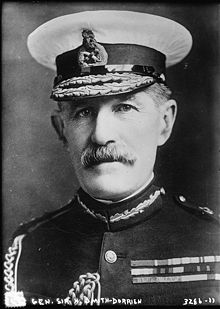 Shortly before the war, British General Horace Smith-Dorrien predicted a catastrophic war which should be avoided at almost any cost.
Shortly before the war, British General Horace Smith-Dorrien predicted a catastrophic war which should be avoided at almost any cost. Rubble covered Sackville Street in Dublin after violence between Irish rebels and UK armed forces during the Easter Rising of 1916.
Rubble covered Sackville Street in Dublin after violence between Irish rebels and UK armed forces during the Easter Rising of 1916.
The trade union and socialist movements had long voiced their opposition to a war, which they argued would mean only that workers would kill other workers in the interest of capitalism. Once war was declared, however, many socialists and trade unions backed their governments. Among the exceptions were the Bolsheviks, the Socialist Party of America, and the Italian Socialist Party, and individuals such as Karl Liebknecht, Rosa Luxemburg, and their followers in Germany. There were also small anti-war groups in Britain and France.
In Britain, in 1914, the Public Schools Officers' Training Corps annual camp was held at Tidworth Pennings, near Salisbury Plain. Head of the British Army Lord Kitchener was to review the cadets, but the imminence of the war prevented him. General Horace Smith-Dorrien was sent instead. He surprised the two-or-three thousand cadets by declaring (in the words of Donald Christopher Smith, a Bermudian cadet who was present), that war should be avoided at almost any cost, that war would solve nothing, that the whole of Europe and more besides would be reduced to ruin, and that the loss of life would be so large that whole populations would be decimated. In our ignorance I, and many of us, felt almost ashamed of a British General who uttered such depressing and unpatriotic sentiments, but during the next four years, those of us who survived the holocaust-probably not more than one-quarter of us - learned how right the General's prognosis was and how courageous he had been to utter it. [190] Voicing these sentiments did not hinder Smith-Dorien's career, or prevent him from doing his duty in World War I to the best of his abilities.
E. D. Morel had been extremely suspicious of the secret diplomacy pursued by the British Foreign Office, and in 1911 he showed how a secret understanding between Britain and France over the control of Morocco, followed by a campaign in the British press based on misleading Foreign Office briefings, had stitched up Germany and very nearly caused a European war. In February 1912, he warned that "no greater disaster could befall both peoples [Britain and Germany], and all that is most worthy of preservation in modern civilization, than a war between them". Convinced that Britain had struck a second secret agreement with France that would drag the nation into any war which involved Russia, he campaigned for such treaties to be made public; for recognition that Germany had been hoodwinked over Morocco; and for the British government to seek to broker a reconciliation between France and Germany. In response, British ministers lied. The prime minister and the foreign secretary repeatedly denied that there was any secret agreement with France. Only on the day war was declared did the foreign secretary admit that a treaty had been in place since 1906. It ensured that Britain would have to fight from the moment Russia mobilised. Morel continued to oppose the war, was reviled in the press and physically attacked seven times for it, and eventually was imprisoned in 1917.[191][192]
At the end of July, 1914, when it became clear to the British government that the country was on the verge of war with Germany, four senior members of the government, David Lloyd George (Chancellor of the Exchequer), Sir Charles Trevelyan (Parliamentary Secretary of the Board of Education), John Burns (President of the Local Government Board), and John Morley (Secretary of State for India), were opposed to the country becoming involved in a European war. They informed the Prime Minister, Herbert Asquith, that they intended to resign over the issue. When war was declared on 4 August, three of the men, Trevelyan, Burns, and Morley, resigned, but Asquith managed to persuade Lloyd George, his Chancellor of the Exchequer, to change his mind. The day after war was declared, Trevelyan began contacting friends about a new political organisation he intended to form to oppose the war. This included two pacifist members of the Liberal Party, Norman Angell and E. D. Morel, and Ramsay MacDonald, the leader of the Labour Party. A meeting was held, and after considering names such as the Peoples' Emancipation Committee and the Peoples' Freedom League, they selected the Union of Democratic Control. The four men agreed that one of the main reasons for the conflict was the secret diplomacy of people like Britain's foreign secretary, Sir Edward Grey. The founders of the Union of Democratic Control produced a manifesto and invited people to support it. Over the next few weeks several leading figures joined the organisation. This included J. A. Hobson, Charles Buxton, Ottoline Morrell, Philip Morrell, Frederick Pethick-Lawrence, Arnold Rowntree, Morgan Philips Price, George Cadbury, Helena Swanwick, Fred Jowett, Tom Johnston, Bertrand Russell, Philip Snowden, Ethel Snowden, David Kirkwood, William Anderson, Mary Sheepshanks, Isabella Ford, H. H. Brailsford, Israel Zangwill, Margaret Llewelyn Davies, Konni Zilliacus, Margaret Sackville and Olive Schreiner. [193]
Ramsay MacDonald came under attack from newspapers because of his opposition to the First World War. On 1 October 1914, The Times published a leading article entitled "Helping the Enemy", in which it wrote that "no paid agent of Germany had served her better" than MacDonald had done. The newspaper also included an article by Ignatius Valentine Chirol, who argued: "We may be rightly proud of the tolerance we display towards even the most extreme licence of speech in ordinary times....Mr. MacDonald's case is a very different one. In time of actual war...Mr. MacDonald has sought to besmirch the reputation of his country by openly charging with disgraceful duplicity the Ministers who are its chosen representatives, and he has helped the enemy State....Such action oversteps the bounds of even the most excessive toleration, and cannot be properly or safely disregarded by the British Government or the British people."
Many countries jailed those who spoke out against the conflict. These included Eugene Debs in the United States and Bertrand Russell in Britain. In the U.S., the Espionage Act of 1917 and Sedition Act of 1918 made it a federal crime to oppose military recruitment or make any statements deemed "disloyal". Publications at all critical of the government were removed from circulation by postal censors,[100] and many served long prison sentences for statements of fact deemed unpatriotic.
A number of nationalists opposed intervention, particularly within states that the nationalists were hostile to. Irish nationalists staunchly opposed taking part in the intervention of the United Kingdom of Great Britain and Ireland.[194] The war began amid the Home Rule crisis in Ireland that had begun in 1912, and by 1914 there was a serious possibility of an outbreak of civil war in Ireland between Irish unionists and republicans.[194] Irish nationalists and Marxists attempted to pursue Irish independence, culminating in the Easter Rising of 1916, with Germany sending 20,000 rifles to Ireland in order to stir unrest in the United Kingdom.[194] The UK government placed Ireland under martial law in response to the Easter Rising.[195]
Other opposition came from conscientious objectors – some socialist, some religious – who refused to fight. In Britain 16,000 people asked for conscientious objector status.[196] Many suffered years of prison, including solitary confinement and bread and water diets. Even after the war, in Britain many job advertisements were marked "No conscientious objectors need apply".
The Central Asian Revolt started in the summer of 1916, when the Russian Empire government ended its exemption of Muslims from military service.[197]
In 1917, a series of mutinies in the French army led to dozens of soldiers being executed and many more imprisoned.
In Milan in May 1917, Bolshevik revolutionaries organised and engaged in rioting calling for an end to the war, and managed to close down factories and stop public transportation.[198] The Italian army was forced to enter Milan with tanks and machine guns to face Bolsheviks and anarchists, who fought violently until May 23 when the army gained control of the city. Almost fifty people (including three Italian soldiers) were killed and over 800 people arrested.[198]
The Conscription Crisis of 1917 in Canada erupted when conservative Prime Minister Robert Borden brought in compulsory military service over the objection of French-speaking Quebecers.[199] Out of approximately 625,000 Canadians who served, about 60,000 were killed and another 173,000 wounded.[200]
In 1917, Emperor Charles I of Austria secretly entered into peace negotiations with the Allied powers, with his brother-in-law Sixtus as intermediary, without the knowledge of his ally Germany. He failed, however, because of the resistance of Italy.[201]
In September 1917, Russian soldiers in France began questioning why they were fighting for the French at all and mutinied.[202] In Russia, opposition to the war led to soldiers also establishing their own revolutionary committees, which helped foment the October Revolution of 1917, with the call going up for "bread, land, and peace". The Bolsheviks agreed to a peace treaty with Germany, the peace of Brest-Litovsk, despite its harsh conditions.
In northern Germany, the end of October 1918, saw the beginning of the German Revolution of 1918–1919. Units of the German Navy refused to set sail for a last, large-scale operation in a war which they saw as good as lost; this initiated the uprising. The sailors' revolt which then ensued in the naval ports of Wilhelmshaven and Kiel spread across the whole country within days and led to the proclamation of a republic on 9 November 1918 and shortly thereafter to the abdication of Kaiser Wilhelm II.
Conscription
As the war slowly turned into a war of attrition, conscription was implemented in some countries. This issue was particularly explosive in Canada and Australia. In the former it opened a political gap between French-Canadians, who claimed their true loyalty was to Canada and not the British Empire, and members of the Anglophone majority, who saw the war as a duty to both Britain and Canada. Prime Minister Robert Borden pushed through a Military Service Act, provoking the Conscription Crisis of 1917. In Australia, a sustained pro-conscription campaign by Prime Minister Billy Hughes caused a split in the Australian Labor Party, so Hughes formed the Nationalist Party of Australia in 1917 to pursue the matter. Nevertheless, the labour movement, the Catholic Church, and Irish nationalist expatriates successfully opposed Hughes' push, which was rejected in two plebiscites.
Conscription put into uniform nearly every physically fit man in Britain, six of ten million eligible. Of these, about 750,000 lost their lives and 1,700,000 were wounded. Most deaths were to young unmarried men; however, 160,000 wives lost husbands and 300,000 children lost fathers.[203]
Aftermath
Main article: Aftermath of World War IHealth and economic effects
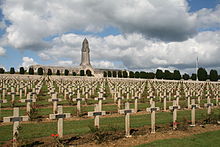 The French military cemetery with Douaumont ossuary, which contains the remains of more than 130,000 unknown soldiers.
The French military cemetery with Douaumont ossuary, which contains the remains of more than 130,000 unknown soldiers.
No other war had changed the map of Europe so dramatically. Four empires disappeared: the German, Austro-Hungarian, Ottoman, and Russian. Four dynasties, together with their ancillary aristocracies, all fell after the war: the Hohenzollerns, the Habsburgs, the Romanovs, and the Ottomans. Belgium and Serbia were badly damaged, as was France, with 1.4 million soldiers dead,[204] not counting other casualties. Germany and Russia were similarly affected.[205]
The war had profound economic consequences. Of the 60 million European soldiers who were mobilised from 1914 to 1918, 8 million were killed, 7 million were permanently disabled, and 15 million were seriously injured. Germany lost 15.1% of its active male population, Austria–Hungary lost 17.1%, and France lost 10.5%.[206] About 750,000 German civilians died from starvation caused by the British blockade during the war.[207] By the end of the war, famine had killed approximately 100,000 people in Lebanon.[208] The best estimates of the death toll from the Russian famine of 1921 run from 5 million to 10 million people.[209] By 1922, there were between 4.5 million and 7 million homeless children in Russia as a result of nearly a decade of devastation from World War I, the Russian Civil War, and the subsequent famine of 1920–1922.[210] Numerous anti-Soviet Russians fled the country after the Revolution; by the 1930s the northern Chinese city of Harbin had 100,000 Russians.[211] Thousands more emigrated to France, England, and the United States.
Diseases flourished in the chaotic wartime conditions. In 1914 alone, louse-borne epidemic typhus killed 200,000 in Serbia.[212] From 1918 to 1922, Russia had about 25 million infections and 3 million deaths from epidemic typhus.[213] Whereas before World War I Russia had about 3.5 million cases of malaria, its people suffered more than 13 million cases in 1923.[214] In addition, a major influenza epidemic spread around the world. Overall, the 1918 flu pandemic killed at least 50 million people.[215][216]
Lobbying by Chaim Weizmann and fear that American Jews would encourage the USA to support Germany culminated in the British government's Balfour Declaration of 1917, endorsing creation of a Jewish homeland in Palestine.[217] A total of more than 1,172,000 Jewish soldiers served in the Allied and Central Power forces in World War I, including 275,000 in Austria-Hungary and 450,000 in Czarist Russia.[218]
 Emergency military hospital during the Spanish flu pandemic, which killed about 675,000 people in the United States alone. Camp Funston, Kansas, 1918
Emergency military hospital during the Spanish flu pandemic, which killed about 675,000 people in the United States alone. Camp Funston, Kansas, 1918
The social disruption and widespread violence of the Revolution of 1917 and the ensuing Russian Civil War sparked more than 2,000 pogroms in the former Russian Empire, mostly in the Ukraine.[219] An estimated 60,000–200,000 civilian Jews were killed in the atrocities.[220]
In the aftermath of World War I, Greece fought against Turkish nationalists led by Mustafa Kemal, a war which resulted in a massive population exchange between the two countries under the Treaty of Lausanne.[221] According to various sources,[222] several hundred thousand Pontic Greeks died during this period.[223]
Peace treaties and national boundaries
After the war, the Paris Peace Conference imposed a series of peace treaties on the Central Powers. The 1919 Treaty of Versailles officially ended the war. Building on Wilson's 14th point, the Treaty of Versailles also brought into being the League of Nations on 28 June 1919.[224][225]
In signing the treaty, Germany acknowledged responsibility for the war, and agreed to pay enormous war reparations and award territory to the victors. The "Guilt Thesis" became a controversial explanation of later events among analysts in Britain and the United States. The Treaty of Versailles caused enormous bitterness in Germany, which nationalist movements, especially the Nazis, exploited with a conspiracy theory they called the Dolchstosslegende (Stab-in-the-back legend). The Weimar Republic lost the former colonial possessions and was saddled with accepting blame for the war, as well as paying punitive reparations for it. Unable to pay them with exports (as a result of territorial losses and postwar recession),[226] Germany did so by borrowing from the United States. Runaway inflation in the 1920s contributed to the economic collapse of the Weimar Republic, and the payment of reparations was suspended in 1931 following the Stock Market Crash of 1929 and the beginnings of the Great Depression worldwide.
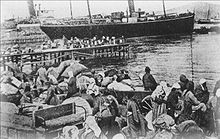 Greek refugees from Smyrna, Turkey, 1922
Greek refugees from Smyrna, Turkey, 1922
Austria–Hungary was partitioned into several successor states, including Austria, Hungary, Czechoslovakia, and Yugoslavia, largely but not entirely along ethnic lines. Transylvania was shifted from Hungary to Greater Romania. The details were contained in the Treaty of Saint-Germain and the Treaty of Trianon. As a result of the Treaty of Trianon, 3.3 million Hungarians came under foreign rule. Although the Hungarians made up 54% of the population of the pre-war Kingdom of Hungary, only 32% of its territory was left to Hungary. Between 1920 and 1924, 354,000 Hungarians fled former Hungarian territories attached to Romania, Czechoslovakia, and Yugoslavia.
The Russian Empire, which had withdrawn from the war in 1917 after the October Revolution, lost much of its western frontier as the newly independent nations of Estonia, Finland, Latvia, Lithuania, and Poland were carved from it. Bessarabia was re-attached to Greater Romania, as it had been a Romanian territory for more than a thousand years.[227]
The Ottoman Empire disintegrated, and much of its non-Anatolian territory was awarded to various Allied powers as protectorates. The Turkish core was reorganised as the Republic of Turkey. The Ottoman Empire was to be partitioned by the Treaty of Sèvres of 1920. This treaty was never ratified by the Sultan and was rejected by the Turkish republican movement, leading to the Turkish Independence War and, ultimately, to the 1923 Treaty of Lausanne.
Legacy
..."Strange, friend," I said, "Here is no cause to mourn." "None," said the other, "Save the undone years"...
— Wilfred Owen, Strange Meeting, 1918[141] Main articles: World War I in popular culture and War memorialThe first tentative efforts to comprehend the meaning and consequences of modern warfare began during the initial phases of the war, and this process continued throughout and after the end of hostilities.
Memorials
Memorials were erected in thousands of villages and towns. Close to battlefields, those buried in improvised burial grounds were gradually moved to formal graveyards under the care of organisations such as the Commonwealth War Graves Commission, the American Battle Monuments Commission, the German War Graves Commission, and Le Souvenir français. Many of these graveyards also have central monuments to the missing or unidentified dead, such as the Menin Gate memorial and the Thiepval Memorial to the Missing of the Somme.
On 3 May 1915, during the Second Battle of Ypres, Lieutenant Alexis Helmer was killed. At his graveside, his friend John McCrae, M.D., of Guelph, Ontario, Canada, wrote the memorable poem In Flanders Fields as a salute to those who perished in the Great War. Published in Punch on 8 December 1915, it is still recited today, especially on Remembrance Day and Memorial Day.[228][229]
Liberty Memorial in Kansas City, Missouri, is a United States memorial dedicated to all Americans who served in World War I. The site for the Liberty Memorial was dedicated on November 1, 1921. On this day, the supreme Allied commanders spoke to a crowd of more than 100,000 people. It was the only time in history these leaders were together in one place. In attendance were Lieutenant General Baron Jacques of Belgium; General Armando Diaz of Italy; Marshal Ferdinand Foch of France; General Pershing of the United States; and Admiral D. R. Beatty of Great Britain. After three years of construction, the Liberty Memorial was completed and President Calvin Coolidge delivered the dedication speech to a crowd of 150,000 people in 1926.
Liberty Memorial is also home to The National World War I Museum, the only museum dedicated solely to World War I in the United States.
Cultural memory
The First World War had a lasting impact on social memory. It was seen by many in Britain as signalling the end of an era of stability stretching back to the Victorian period, and across Europe many regarded it as a watershed.[230] Historian Samuel Hynes explained:
A generation of innocent young men, their heads full of high abstractions like Honour, Glory and England, went off to war to make the world safe for democracy. They were slaughtered in stupid battles planned by stupid generals. Those who survived were shocked, disillusioned and embittered by their war experiences, and saw that their real enemies were not the Germans, but the old men at home who had lied to them. They rejected the values of the society that had sent them to war, and in doing so separated their own generation from the past and from their cultural inheritance.[231]This has become the most common perception of the First World War, perpetuated by the art, cinema, poems, and stories published subsequently. Films such as All Quiet on the Western Front, Paths of Glory and King & Country have perpetuated the idea, while war-time films including Camrades, Flanders Poppies, and Shoulder Arms indicate that the most contemporary views of the war were overall far more positive.[232] Likewise, the art of Paul Nash, John Nash, Christopher Nevison, and Henry Tonks in Britain painted a negative view of the conflict in keeping with the growing perception, while popular war-time artists such as Muirhead Bone painted more serene and pleasant interpretations subsequently rejected as inaccurate.[231] Several historians[who?] have since countered these interpretations:
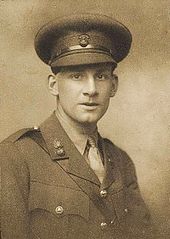 Siegfried Sassoon (May 1915)
Siegfried Sassoon (May 1915)
These beliefs did not become widely shared because they offered the only accurate interpretation of wartime events. In every respect, the war was much more complicated than they suggest. In recent years, historians have argued persuasively against almost every popular cliché of the First World War. It has been pointed out that, although the losses were devastating, their greatest impact was socially and geographically limited. The many emotions other than horror experienced by soldiers in and out of the front line, including comradeship, boredom, and even enjoyment, have been recognised. The war is not now seen as a 'fight about nothing', but as a war of ideals, a struggle between aggressive militarism and more or less liberal democracy. It has been acknowledged that British generals were often capable men facing difficult challenges, and that it was under their command that the British army played a major part in the defeat of the Germans in 1918: a great forgotten victory.[232]
Though these historians have discounted as "myths"[231][233] these perceptions of the war, they are nevertheless prevalent across much of society.[citation needed] They have dynamically changed according to contemporary influences, reflecting in the 1950s perceptions of the war as 'aimless' following the contrasting Second World War, and emphasising conflict within the ranks during times of class conflict in the 1960s.[232] The majority of additions to the contrary are often rejected.[232]
Social trauma
The social trauma caused by unprecedented rates of casualties manifested itself in different ways, which have been the subject of subsequent historical debate.[234] Some people[who?] were revolted by nationalism and its results, and began to work towards a more internationalist world, supporting organisations such as the League of Nations. Pacifism became increasingly popular. Others had the opposite reaction, feeling that only strength and military might could be relied upon in a chaotic and inhumane world. Anti-modernist views were an outgrowth of the many changes taking place in society.
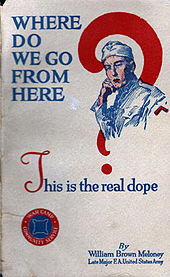 Book distributed by the U.S. War Department to veterans in 1919
Book distributed by the U.S. War Department to veterans in 1919
The experiences of the war led to a collective trauma shared by many from all participating countries. The optimism of la belle époque was destroyed, and those who had fought in the war were referred to as the Lost Generation.[235] For years afterwards, people mourned the dead, the missing, and the many disabled.[236] Many soldiers returned with severe trauma, suffering from shell shock (also called neurasthenia, now called posttraumatic stress disorder).[237] Many more returned home with few after-effects; however, their silence about the war contributed to the conflict's growing mythological status.[234] In the United Kingdom, mass mobilisation, large casualty rates, and the collapse of the Edwardian era made a strong impression on society. Though many participants did not share in the experiences of combat or spend any significant time at the front, or had positive memories of their service, the images of suffering and trauma became the widely shared perception.[234] Such historians as Dan Todman, Paul Fussell, and Samuel Heyns have all published works since the 1990s arguing that these common perceptions of the war are factually incorrect.[234]
Discontent in Germany
The rise of Nazism and fascism included a revival of the nationalist spirit and a rejection of many post-war changes. Similarly, the popularity of the Stab-in-the-back legend (German: Dolchstoßlegende) was a testament to the psychological state of defeated Germany and was a rejection of responsibility for the conflict. This conspiracy theory of betrayal became common, and the German populace came to see themselves as victims. The Dolchstoßlegende's popular acceptance in Germany played a significant role in the rise of Nazism. A sense of disillusionment and cynicism became pronounced, with nihilism growing. Many believed the war heralded the end of the world as they had known it because of the high fatalities among a generation of men, the dissolution of governments and empires, and the collapse of capitalism and imperialism.
Communist and socialist movements around the world drew strength from this theory and enjoyed a new level of popularity. These feelings were most pronounced in areas directly or harshly affected by the war. Out of German discontent with the still controversial Treaty of Versailles, Adolf Hitler was able to gain popularity and power.[238][239] World War II was in part a continuation of the power struggle never fully resolved by the First World War; in fact, it was common for Germans in the 1930s and 1940s to justify acts of international aggression because of perceived injustices imposed by the victors of the First World War.[240][241][242]
The establishment of the modern state of Israel and the roots of the continuing Israeli-Palestinian Conflict are partially found in the unstable power dynamics of the Middle East which resulted from World War I.[243] Prior to the end of the war, the Ottoman Empire had maintained a modest level of peace and stability throughout the Middle East.[244] With the fall of the Ottoman government, power vacuums developed and conflicting claims to land and nationhood began to emerge.[245] The political boundaries drawn by the victors of the First World War were quickly imposed, sometimes after only cursory consultation with the local population. In many cases, these continue to be problematic in the 21st-century struggles for national identity.[246][247] While the dissolution of the Ottoman Empire at the end of World War I was pivotal in contributing to the modern political situation of the Middle East, including the Arab-Israeli conflict,[248][249][250] the end of Ottoman rule also spawned lesser known disputes over water and other natural resources.[251]
Further information: Sykes–Picot Agreement The announcing of the armistice on November 11, 1918. Philadelphia.
The announcing of the armistice on November 11, 1918. Philadelphia.
Views in the United States
U.S. intervention in the war, as well as the Wilson administration itself, became deeply unpopular. This was reflected in the U.S. Senate's rejection of the Versailles Treaty and membership in the League of Nations. In the interwar era, a consensus arose that U.S. intervention had been a mistake, and the Congress passed laws in an attempt to preserve U.S. neutrality in any future conflict. Polls taken in 1937 and the opening months of World War II established that nearly 60% regarded intervention in WWI as a mistake, with only 28% opposing that view. But, in the period between the fall of France and the attack on Pearl Harbor, public opinion changed dramatically and, for the first time, a narrow plurality rejected the idea that the war had been a mistake.[252]
New national identities
Poland reemerged as an independent country, after more than a century. As a "minor Entente nation" and the country with the most casualties per capita,[253][254][255] the Kingdom of Serbia and its dynasty became the backbone of the new multinational state, the Kingdom of Serbs, Croats and Slovenes (later renamed Yugoslavia). Czechoslovakia, combining the Kingdom of Bohemia with parts of the Kingdom of Hungary, became a new nation. Russia became the Soviet Union and lost Finland, Estonia, Lithuania, and Latvia, which became independent countries. The Ottoman Empire was soon replaced by Turkey and several other countries in the Middle East.
In the British Empire, the war unleashed new forms of nationalism. In Australia and New Zealand the Battle of Gallipoli became known as those nations' "Baptism of Fire". It was the first major war in which the newly established countries fought, and it was one of the first times that Australian troops fought as Australians, not just subjects of the British Crown. Anzac Day, commemorating the Australian and New Zealand Army Corps, celebrates this defining moment.[256][257]
After the Battle of Vimy Ridge, where the Canadian divisions fought together for the first time as a single corps, Canadians began to refer to theirs as a nation "forged from fire".[258] Having succeeded on the same battleground where the "mother countries" had previously faltered, they were for the first time respected internationally for their own accomplishments. Canada entered the war as a Dominion of the British Empire and remained so, although she emerged with a greater measure of independence.[259][260] While the other Dominions were represented by Britain, Canada was an independent negotiator and signatory of the Versailles Treaty.
Economic effects
One of the most dramatic effects of the war was the expansion of governmental powers and responsibilities in Britain, France, the United States, and the Dominions of the British Empire. In order to harness all the power of their societies, governments created new ministries and powers. New taxes were levied and laws enacted, all designed to bolster the war effort; many have lasted to this day. Similarly, the war strained the abilities of some formerly large and bureaucratised governments, such as in Austria–Hungary and Germany; however, any analysis of the long-term effects were clouded by the defeat of these governments.
 Germany, 1923: banknotes had lost so much value that they were used as wallpaper. Millions of middle-class Germans were ruined by hyperinflation. When the war began in 1914, a dollar was worth 4.2 marks; by November 1923, the dollar was at 4.2 trillion[261] marks.[262]
Germany, 1923: banknotes had lost so much value that they were used as wallpaper. Millions of middle-class Germans were ruined by hyperinflation. When the war began in 1914, a dollar was worth 4.2 marks; by November 1923, the dollar was at 4.2 trillion[261] marks.[262]
Gross domestic product (GDP) increased for three Allies (Britain, Italy, and U.S.), but decreased in France and Russia, in neutral Netherlands, and in the three main Central Powers. The shrinkage in GDP in Austria, Russia, France, and the Ottoman Empire reached 30 to 40%. In Austria, for example, most pigs were slaughtered, so at war's end there was no meat.
In all nations the government's share of GDP increased, surpassing fifty percent in both Germany and France and nearly reaching that level in Britain. To pay for purchases in the United States, Britain cashed in its extensive investments in American railroads and then began borrowing heavily on Wall Street. President Wilson was on the verge of cutting off the loans in late 1916, but allowed a great increase in U.S. government lending to the Allies. After 1919, the U.S. demanded repayment of these loans. The repayments were, in part, funded by German reparations, which, in turn, were supported by American loans to Germany. This circular system collapsed in 1931 and the loans were never repaid. In 1934, Britain owed the US $4.4 billion[263] of World War I debt.[264]
Macro- and micro-economic consequences devolved from the war. Families were altered by the departure of many men. With the death or absence of the primary wage earner, women were forced into the workforce in unprecedented numbers. At the same time, industry needed to replace the lost labourers sent to war. This aided the struggle for voting rights for women.
In Britain, rationing was finally imposed in early 1918, limited to meat, sugar, and fats (butter and oleo), but not bread. The new system worked smoothly. From 1914 to 1918 trade union membership doubled, from a little over four million to a little over eight million. Work stoppages and strikes became frequent in 1917–1918 as the unions expressed grievances regarding prices, alcohol control, pay disputes, fatigue from overtime and working on Sundays, and inadequate housing.
Britain turned to her colonies for help in obtaining essential war materials whose supply had become difficult from traditional sources. Geologists such as Albert Ernest Kitson were called upon to find new resources of precious minerals in the African colonies. Kitson discovered important new deposits of manganese, used in munitions production, in the Gold Coast.[265]
Article 231 of the Treaty of Versailles (the so-called "war guilt" clause) declared Germany and its allies responsible for all "loss and damage" suffered by the Allies during the war and provided the basis for reparations. The total reparations demanded was 132 billion gold marks, which was far more than the total German gold or foreign exchange. The economic problems that the payments brought, and German resentment at their imposition, are usually cited as one of the more significant factors that led to the end of the Weimar Republic and the beginning of the dictatorship of Adolf Hitler. After Germany’s defeat in World War II, payment of the reparations was not resumed. There was, however, outstanding German debt that the Weimar Republic had used to pay the reparations. Germany finished paying off the reparations in October 2010.[266]
Notes
- ^ a b Tucker & Roberts 2005, p. 273
- ^ Figures are for the British Empire
- ^ Figures are for Metropolitan France and its colonies
- ^ Willmott 2003, pp. 10–11
- ^ a b c d Willmott 2003, p. 15
- ^ Keegan 1988, p. 8
- ^ Bade & Brown 2003, pp. 167–168
- ^ Willmott 2003, p. 307
- ^ a b c d Taylor 1998, pp. 80–93
- ^ Djokić 2003, p. 24
- ^ Evans 2004, p. 12
- ^ Martel 2003, p. xii ff
- ^ Keegan 1988, p. 7
- ^ Keegan 1988, p. 11
- ^ [1].
- ^ [2]
- ^ [3].
- ^ [4].
- ^ [5], Time Magazine.
- ^ Shapiro 2006, p. 329 citing a wire service report in The Indianapolis Star, 20 September 1914
- ^ a b Keegan 1998, p. 52
- ^ a b Willmott 2003, p. 21
- ^ Prior 1999, p. 18
- ^ Fromkin 2004, p. 94
- ^ a b Keegan 1998, pp. 48–49
- ^ Willmott 2003, pp. 2–23
- ^ Willmott 2003, p. 26
- ^ Willmott 2003, p. 27
- ^ Strachan 2003, p. 68
- ^ Willmott 2003, p. 29
- ^ "Daily Mirror Headlines: The Declaration of War, Published 4 August 1914". bbc.co.uk. http://www.bbc.co.uk/history/worldwars/wwone/mirror01_01.shtml. Retrieved 9 February 2010.
- ^ Strachan 2003, pp. 292–296, 343–354
- ^ Farwell 1989, p. 353
- ^ Tucker & Roberts 2005, p. 172
- ^ Tucker & Roberts 2005, pp. 376–8
- ^ Keegan 1968, pp. 224–232
- ^ Falls 1960, pp. 79–80
- ^ Raudzens 1990, pp. 424
- ^ Raudzens 1990, pp. 421–423
- ^ Goodspeed 1985, p. 199 (footnote)
- ^ Love 1996
- ^ Duffy
- ^ Tucker & Roberts 2005, p. 1221
- ^ Tucker & Roberts 2005, p. 854
- ^ Heer 2009, pp. 223–4
- ^ Goodspeed 1985, p. 226
- ^ Ludendorff 1919, p. 480
- ^ a b c Terraine 1963
- ^ Perry 1988, p. 27
- ^ "Vimy Ridge, Canadian National Memorial", Australians on the Western Front 1914–1918 (New South Wales Department of Veteran's Affairs and Board of Studies), 2007, http://www.ww1westernfront.gov.au/vimy-ridge/index.html
- ^ Winegard
- ^ Taylor 2007, pp. 39–47
- ^ Keene 2006, p. 5
- ^ Halpern 1995, p. 293
- ^ Zieger 2001, p. 50
- ^ Tucker & Roberts 2005, pp. 619–24
- ^ a b c d Sheffield, Garry, "The First Battle of the Atlantic", World Wars In Depth (BBC), http://www.bbc.co.uk/history/worldwars/wwone/battle_atlantic_ww1_01.shtml, retrieved 2009-11-11
- ^ Gilbert 2004, p. 306
- ^ von der Porten 1969
- ^ Jones 2001, p. 80
- ^ "Nova Scotia House of Assembly Committee on Veterans' Affairs", Hansard, http://www.gov.ns.ca/legislature/hansard//comm/va/va_2006nov09.htm, retrieved 2007-10-30
- ^ Roger Chickering, Stig Förster, Bernd Greiner, German Historical Institute (Washington, D.C.) (2005). "A world at total war: global conflict and the politics of destruction, 1937-1945". Cambridge University Press. p.73. ISBN 0521834325
- ^ Price
- ^ "The Balkan Wars and World War I". Library of Congress Country Studies.
- ^ Neiberg 2005, pp. 54–55
- ^ Tucker & Roberts 2005, pp. 1075–6
- ^ Neiberg 2005, pp. 108–10
- ^ Tucker, Wood & Murphy 1999, p. 120
- ^ Pyrrhic victory: French strategy and operations in the Great War, Harvard University Press, 2005;, 2005, p. 491, ISBN 9780674018808, http://books.google.com/?id=vZRmHkdGk44C&pg=PA247&dq=vardar+offensive#v=onepage&q=vardar%20offensive&f=false, retrieved 2010-10-03
- ^ a b "The Balkan Front of the World War (in Russian)". militera.lib.ru. http://militera.lib.ru/h/korsun_ng4/06.html. Retrieved 2010-09-27.
- ^ The Treaty of Alliance Between Germany and Turkey 2 August 1914, Yale University
- ^ Fromkin 2001, p. 119
- ^ a b Hinterhoff 1984, pp. 499–503
- ^ Boghos Nubar, the president of the "Armenian National Assembly", declared to Paris Peace Conference, 1919 through a letter to French Foreign Office – 3 December 1918
- ^ Sachar, pp. 122–138
- ^ Gilbert 1994
- ^ Page
- ^ Hickey 2003, pp. 60–65
- ^ Tucker 2005, pp. 585–9
- ^ "The Battle of Marasti (July 1917)". WorldWar2.ro. 1917-07-22. http://www.worldwar2.ro/primulrazboi/?language=en&article=116. Retrieved 2011-05-08.
- ^ Cyril Falls, The Great War, p. 285
- ^ Béla, Köpeczi, Erdély története, Akadémiai Kiadó, http://mek.oszk.hu/02100/02109/html/571.html
- ^ Béla, Köpeczi, History of Transylvania, Akadémiai Kiadó, ISBN 848371020X, http://mek.niif.hu/03400/03407/html/429.html
- ^ Erlikman, Vadim (2004), Poteri narodonaseleniia v XX veke : spravochnik, Moscow, ISBN 5-93165-107-1
- ^ Brown 1994, pp. 197–198
- ^ Brown 1994, pp. 201–203
- ^ Participants from the Indian subcontinent in the First World War, Memorial Gates Trust, http://www.mgtrust.org/ind1.htm, retrieved 2008-12-12
- ^ Tucker 2005, p. 715
- ^ Meyer 2006, pp. 152–4, 161, 163, 175, 182
- ^ a b Smele
- ^ Schindler 2003
- ^ Wheeler-Bennett 1956
- ^ Mawdsley 2008, pp. 54–55
- ^ Kernek 1970, pp. 721–766
- ^ Stracham (1998), p. 61
- ^ Lyons 1999, p. 243
- ^ Marshall, 292.
- ^ Heyman 1997, pp. 146–147
- ^ Brands 1997, p. 756
- ^ a b Karp 1979
- ^ Tuchman 1966
- ^ "Woodrow Wilson Urges Congress to Declare War on Germany" (Wikisource)
- ^ "Selective Service System: History and Records". Sss.gov. http://www.sss.gov/induct.htm. Retrieved 2010-07-27.
- ^ Wilgus, p. 52
- ^ Teaching With Documents: Photographs of the 369th Infantry and African Americans during World War I, U.S. National Archives and Records Administration, http://www.archives.gov/education/lessons/369th-infantry/, retrieved 2009-10-29
- ^ Millett & Murray 1988, p. 143
- ^ Kurlander 2006
- ^ Shanafelt 1985, pp. 125–30
- ^ Westwell 2004
- ^ Posen 1984, pp. 190&191
- ^ Gray 1991, p. 86
- ^ a b Moon 1996, pp. 495–196
- ^ Rickard 2007
- ^ See Hovannisian, Richard G. (1967). Armenia on the Road to Independence, 1918. Berkeley: University of California Press. ISBN 0-5200-0574-0.
- ^ a b The Battle of Amiens: 8 August 1918, Australian War Memorial, http://www.awm.gov.au/1918/battles/amiens.htm, retrieved 2008-12-12
- ^ Amiens Map, Australian War Memorial, archived from the original on 2007-06-17, http://web.archive.org/web/20070617055415/http://www.awm.gov.au/1918/battles/amiensmap.htm, retrieved 2009-10-24 (archived 2007-06-17)
- ^ Rickard 2001
- ^ a b c d Pitt 2003
- ^ Maurice 1918
- ^ a b c d Gray & Argyle 1990
- ^ Nicholson 1962
- ^ Ludendorff 1919
- ^ Jenkins 2009, p. 215
- ^ McLellan, p. 49
- ^ Gibbs 1918b
- ^ Gibbs 1918a
- ^ Stevenson 2004, p. 380
- ^ Hull 2006, pp. 307–10
- ^ Stevenson 2004, p. 383
- ^ Stevenson 2004
- ^ (in French) Clairière de l'Armistice, Ville de Compiègne, http://www.compiegne.fr/decouvrir/clairierearmistice.asp, retrieved 2008-12-03
- ^ a b "1918 Timeline". League of Nations Photo Archive. http://www.indiana.edu/~league/1918.htm. Retrieved 2009-11-20.
- ^ Lindsay, Robert, "The Last Hours", 28th (Northwest) Battalion Headquarters, http://www.nwbattalion.com/last.html, retrieved 2009-11-20
- ^ Baker 2006
- ^ Chickering 2004, pp. 185–188
- ^ Hartcup 1988, p. 154
- ^ Hartcup 1988, pp. 82–86
- ^ Mosier 2001, pp. 42–48
- ^ Harcup 1988
- ^ Raudzens, p. 421
- ^ a b Wilfred Owen: poems, (Faber and Faber, 2004)
- ^ Raudzens
- ^ Heller 1984
- ^ Postwar pulp novels on future "gas wars" included Reginald Glossop's 1932 novel Ghastly Dew and Neil Bell's 1931 novel The Gas War of 1940.
- ^ Eric Lawson, Jane Lawson (2002). "The First Air Campaign: August 1914- November 1918". Da Capo Press. p.123. ISBN 0306812134
- ^ a b Cross 1991
- ^ Cross 1991, pp. 56–57
- ^ Price 1980
- ^ Winter 1983
- ^ a b Johnson 2001
- ^ a b International Association of Genocide Scholars (13 June 2005). "Open Letter to the Prime Minister of Turkey Recep Tayyip Erdoğan". Genocide Watch (via archive.org). Archived from the original on 2007-10-06. http://web.archive.org/web/20071006024502/http://www.genocidewatch.org/TurkishPMIAGSOpenLetterreArmenia6-13-05.htm.
- ^ Lewy 2005, p. 57
- ^ Ferguson 2006, p. 177
- ^ Balakian 2003, pp. 195–196
- ^ Fromkin 1989, pp. 212–215
- ^ A People on the Move: Germans in Russia and in the Former Soviet Union: 1763–1997, North Dakota State University Libraries, http://lib.ndsu.nodak.edu/grhc/history_culture/history/people.html, retrieved 2009-11-17
- ^ WWI and the Jews, MyJewishLearning.com, http://www.myjewishlearning.com/history/Modern_History/1914-1948/WWI_and_the_Jews.shtml, retrieved 2009-11-17
- ^ Timeline 1900s, The Library of Congress, http://www.loc.gov/exhibits/haventohome/timeline/haven-timeline_3.html
- ^ The Germans from Russia: Children of the Steppe/Children of the Prairie, Prairie Public Broadcasting, http://archive.prairiepublic.org/features/GFR/timeline.htm, retrieved 2009-11-17
- ^ "Pogroms", Encyclopaedia Judaica (Jewish Virtual Library), http://www.jewishvirtuallibrary.org/jsource/judaica/ejud_0002_0016_0_15895.html, retrieved 2009-11-17
- ^ Jewish Modern and Contemporary Periods (ca. 1700–1917), Jewish Virtual Library, http://www.jewishvirtuallibrary.org/jsource/History/modtimeline.html, retrieved 2009-11-17
- ^ Keegan 1998, pp. 82–83
- ^ Forgotten Voices of the Great War, Imperial War Museum, http://www.forgottenvoices.co.uk/, retrieved 2008-03-30
- ^ Phillimore & Bellot 1919, pp. 4–64
- ^ Ferguson 1999, pp. 368–9
- ^ Blair 2005
- ^ Cook 2006, pp. 637&-665
- ^ Speed 1990
- ^ Ferguson 1999
- ^ Morton 1992
- ^ Bass 2002, p. 107
- ^ The Mesopotamia campaign, British National Archives, http://www.nationalarchives.gov.uk/pathways/firstworldwar/battles/mesopotamia.htm, retrieved 2007-03-10
- ^ "Prisoners of Turkey: Men of Kut Driven along like beasts", Stolen Years: Australian Prisoners of War (Australian War Memorial), http://www.awm.gov.au/stolenyears/ww1/turkey/story2.asp, retrieved 2008-12-10
- ^ "ICRC in WWI: overview of activities". Icrc.org. http://www.icrc.org/Web/Eng/siteeng0.nsf/html/57JQGQ. Retrieved 2010-06-15.
- ^ Monday, Sep. 01, 1924 (1924-09-01). "GERMANY: Notes, Sep. 1, 1924". Time.com. http://www.time.com/time/magazine/article/0,9171,768983,00.html. Retrieved 2010-06-15.
- ^ Fortescue 28 October 1915, p. 1
- ^ Granville Roland Fortescue, Arlington National Cemetery, http://www.arlingtoncemetery.net/fortesc.htm, retrieved 2009-11-17
- ^ Sisemore 2003
- ^ a b Tucker & Roberts 2005, p. 1189
- ^ a b Tucker & Roberts 2005, p. 117
- ^ Tucker & Roberts 2005, p. 335
- ^ Tucker & Roberts 2005, p. 219
- ^ a b Tucker & Roberts 2005, p. 1001
- ^ Tucker & Roberts 2005, p. 1069
- ^ Tucker & Roberts 2005, p. 884
- ^ Tucker & Roberts 2005, p. 209
- ^ a b Tucker & Roberts 2005, p. 596
- ^ Tucker & Roberts 2005, p. 826
- ^ Dennis Mack Smith. 1997. Modern Italy; A Political History. Ann Arbor: The University of Michigan Press. Pp. 284.
- ^ "Merely For the Record": The Memoirs of Donald Christopher Smith 1894-1980. By Donald Christopher Smith. Edited by John William Cox, Jr. Bermuda.
- ^ "E.D. Morel and writing for a change". 11 11 July 2009. http://mexfiles.net/2009/07/10/e-d-morel-and-writing-for-a-change/. Retrieved July 23, 2011.
- ^ Monbiot, George (11 November 2008). "Lest we forget: the generals chose to kill their sons rather than their policies". The Guardian (London). http://www.guardian.co.uk/commentisfree/2008/nov/11/first-world-war-edmund-morel. Retrieved July 23, 2011.
- ^ "Union of Democratic Control". http://www.spartacus.schoolnet.co.uk/FWWudc.htm. Retrieved July 23, 2011.
- ^ a b c Tucker & Roberts 2005, p. 584
- ^ Tucker & Roberts 2005, p. 586
- ^ Lehmann 1999, p. 62
- ^ Uzbeks. Based on the Country Studies Series by Federal Research Division of the Library of Congress.
- ^ a b Seton-Watson, Christopher. 1967. Italy from Liberalism to Fascism: 1870 to 1925. London: Methuen & Co. Ltd. Pp. 471
- ^ "The Conscription Crisis". CBC.ca.
- ^ World War I, Encyclopædia Britannica, http://www.britannica.com/EBchecked/topic/91513/Canada/43004/World-War-I, retrieved 2009-12-05.
- ^ "Charles (I) (emperor of Austria)". "Encyclopædia Britannica."
- ^ Cockfield 1997, pp. 171–237
- ^ Havighurst 1985, p. 131
- ^ "France's oldest WWI veteran dies", BBC News, 20 Jan 2008.
- ^ Spencer Tucker (2005), Encyclopedia of World War I, ABC-CLIO, p. 273. ISBN 1851094202
- ^ Kitchen 2000, p. 22
- ^ "Lebensmittelversorgung" (in German), LeMO: Lebendiges virtuelles Museum Online (German Historical Museum), ISBN 3515048057, http://www.dhm.de/lemo/html/wk1/wirtschaft/versorgung/index.html, retrieved 2009-11-12, "Die miserable Versorgung mit Lebensmitteln erreichte 1916/17 im "Kohlrübenwinter" einen dramatischen Höhepunkt. Während des Ersten Weltkriegs starben in Deutschland rund 750.000 Menschen an Unterernährung und an deren Folgen."
- ^ Saadi
- ^ "Food as a Weapon", Hoover Digest (Hoover Institution), http://www.hoover.org/publications/digest/6731711.html
- ^ Ball 1996, pp. 16, 211
- ^ The Russians are coming (Russian influence in Harbin, Manchuria, China; economic relations), The Economist (US), January 1995, http://findarticles.com/p/articles/mi_hb5037/is_199501/ai_n18298515/, retrieved 2009-11-17[dead link]
- ^ Tschanz
- ^ Conlon
- ^ William Hay Taliaferro, Medicine and the War,(1972), p.65. ISBN 0836926293
- ^ Knobler 2005
- ^ Influenza Report, http://www.influenzareport.com/ir/overview.htm, retrieved 2009-11-17
- ^ "Balfour Declaration" (United Kingdom 1917), Encyclopaedia Britannica.
- ^ "The Jewish Agency for Israel Timeline"
- ^ "Pogroms", Encyclopaedia Judaica, http://www.jewishvirtuallibrary.org/jsource/judaica/ejud_0002_0016_0_15895.html, retrieved 2009-11-17
- ^ "Jewish Modern and Contemporary Periods (ca. 1700–1917)", Jewish Virtual Library, http://www.jewishvirtuallibrary.org/jsource/History/modtimeline.html, retrieved 2009-11-17
- ^ "The Diaspora Welcomes the Pope", Der Spiegel Online. November 28, 2006.
- ^ R. J. Rummel, "The Holocaust in Comparative and Historical Perspective," 1998, Idea Journal of Social Issues, Vol.3 no.2
- ^ Chris Hedges, "A Few Words in Greek Tell of a Homeland Lost", The New York Times, 17 Sep 2000
- ^ Magliveras 1999, pp. 8–12
- ^ Northedge 1986, pp. 35–36
- ^ Keynes 1920
- ^ Clark 1927
- ^ John McCrae, Historica, http://www.histori.ca/minutes/minute.do?id=10200
- ^ Evans David, "John McCrae", Canadian Encyclopedia, http://www.thecanadianencyclopedia.com/index.cfm?PgNm=TCE&ArticleId=A0004849
- ^ Mark David Sheftall, Altered Memories of the Great War: Divergent Narratives of Britain, Australia, New Zealand, and Canada (2010)
- ^ a b c Hynes, Samuel Lynn (1991), A war imagined: the First World War and English culture, Atheneum, pp. i–xii, ISBN 9780689121289
- ^ a b c d Todman, Daniel (2005), The Great War: myth and memory, Hambledon and London, pp. 153–221, ISBN 9781852854591
- ^ Fussell, Paul (2000), The Great War and modern memory, Oxford University Press US, pp. 1–78, ISBN 9780195133325, http://books.google.com/?id=D9iNQYfeKdwC, retrieved 18 May 2010
- ^ a b c d Todman, D. The Great War, Myth and Memory, p. xi–xv.
- ^ Roden
- ^ Wohl 1979
- ^ Tucker & Roberts 2005, pp. 108–1086
- ^ The Ending of World War One, and the Legacy of Peace, BBC, http://www.bbc.co.uk/history/worldwars/wwone/war_end_01.shtml
- ^ The Rise of Hitler, http://www.schoolshistory.org.uk/hitlergainspower.htm, retrieved 2009-11-12
- ^ "World War II", Britannica Online Encyclopedia (Encyclopædia Britannica Inc.), archived from the original on 2008-07-04, http://web.archive.org/web/20080704030736/http://www.britannica.com/eb/article-9110199/World-War-II, retrieved 2009-11-12
- ^ Baker, Kevin (June 2006), "Stabbed in the Back! The past and future of a right-wing myth", Harper's Magazine, http://harpers.org/StabbedInTheBack.html
- ^ Chickering 2004
- ^ Economist 2005
- ^ Hooker 1996
- ^ Muller 2008
- ^ Kaplan 1993
- ^ Salibi 1993
- ^ Evans 2005
- ^ Israeli Foreign Ministry
- ^ Gelvin 2005
- ^ Isaac & Hosh 1992
- ^ "1941 Gallup poll". News.google.com. http://news.google.com/newspapers?id=RPUaAAAAIBAJ&sjid=YEwEAAAAIBAJ&pg=3742,5638207&dq=war+poll&hl=en. Retrieved 2010-06-15.
- ^ "Appeals to Americans to Pray for Serbians". The New York Times. July 27, 1918. http://query.nytimes.com/mem/archive-free/pdf?_r=1&res=9406E4D8143EE433A25754C2A9619C946996D6CF.
- ^ "Serbia Restored". The New York Times. November 5, 1918. http://query.nytimes.com/mem/archive-free/pdf?_r=1&res=990CEFDC113BEE3ABC4D53DFB7678383609EDE.
- ^ Simpson, Matt (22 August 2009). "The Minor Powers During World War One – Serbia". firstworldwar.com. http://www.firstworldwar.com/features/minorpowers_serbia.htm.
- ^ "'ANZAC Day' in London; King, Queen, and General Birdwood at Services in Abbey". The New York Times. 26 April 1916. http://query.nytimes.com/gst/abstract.html?res=9400E1DD113FE233A25755C2A9629C946796D6CF&scp=12&sq=New+Zealand+anzac&st=p.
- ^ The ANZAC Day tradition, Australian War Memorial, http://www.awm.gov.au/commemoration/anzac/anzac_tradition.asp, retrieved 2008-05-02
- ^ Vimy Ridge, Canadian War Museum, http://www.warmuseum.ca/cwm/exhibitions/guerre/vimy-ridge-e.aspx, retrieved 2008-10-22
- ^ The War's Impact on Canada, Canadian War Museum, http://www.warmuseum.ca/cwm/exhibitions/guerre/war-impact-e.aspx, retrieved 2008-10-22
- ^ Canada's last WW1 vet gets his citizenship back, CBC News, 2008-05-09, http://www.cbc.ca/canada/ottawa/story/2008/05/09/babcock-citizen.html
- ^ 1012 in this context – see Long and short scales
- ^ "Germany in the Era of Hyperinflation". Spiegel Online. August 14, 2009.
- ^ 109 in this context – see Long and short scales
- ^ "What's a little debt between friends?". BBC News. May 10, 2006.
- ^ Green 1938, pp. CXXVI
- ^ "Germany finishes paying WWI reparations, ending century of 'guilt'". http://www.csmonitor.com/World/Europe/2010/1004/Germany-finishes-paying-WWI-reparations-ending-century-of-guilt. Christian Science Monitor. 4 October 2010.
References
For a comprehensive bibliography see List of books about World War I
- American Armies and Battlefields in Europe: A History, Guide, and Reference Book, U.S. Government Printing Office, 1938, OCLC 59803706, http://www.secstate.wa.gov/history/ww1/maps.aspx
- Army Art of World War I, United States Army Center of Military History: Smithsonian Institution, National Museum of American History, 1993, OCLC 28608539, http://www.secstate.wa.gov/history/publications_detail.aspx?p=28
- Asghar, Syed Birjees (2005-06-12), A Famous Uprising, Dawn Group, archived from the original on 2007-08-03, http://web.archive.org/web/20070803144344/http://www.dawn.com/weekly/dmag/archive/050612/dmag14.htm, retrieved 2007-11-02
- Ashworth, Tony (2000) [1980], Trench warfare, 1914–18 : the live and let live system, London: Pan, ISBN 0330480685, OCLC 247360122
- Bade, Klaus J; Brown, Allison (tr.) (2003), Migration in European History, The making of Europe, Oxford: Blackwell, ISBN 0631189394, OCLC 52695573 (translated from the German)
- Baker, Kevin (June 2006), "Stabbed in the Back! The past and future of a right-wing myth", Harper's Magazine
- Balakian, Peter (2003), The Burning Tigris: The Armenian Genocide and America's Response, New York: HarperCollins, ISBN 9780060198404, OCLC 56822108
- Ball, Alan M (1996), And Now My Soul Is Hardened: Abandoned Children in Soviet Russia, 1918–1930, Berkeley: University of California Press, ISBN 9780520206946, reviewed in Hegarty, Thomas J (March–June 1998), "And Now My Soul Is Hardened: Abandoned Children in Soviet Russia, 1918–1930", Canadian Slavonic Papers, http://findarticles.com/p/articles/mi_qa3763/is_/ai_n8801575
- Bass, Gary Jonathan (2002), Stay the Hand of Vengeance: The Politics of War Crimes Tribunals, Princeton, New Jersey: Princeton University Press, pp. 424pp, ISBN 0691092788, OCLC 248021790
- Blair, Dale (2005), No Quarter: Unlawful Killing and Surrender in the Australian War Experience, 1915–1918, Charnwood, Australia: Ginninderra Press, ISBN 1740272919, OCLC 62514621
- Brands, Henry William (1997), T. R.: The Last Romantic, New York: Basic Books, ISBN 0465069584, OCLC 36954615
- Brown, Judith M. (1994), Modern India: The Origins of an Asian Democracy, Oxford and New York: Oxford University Press. Pp. xiii, 474, ISBN 0198731132.
- Chickering, Rodger (2004), Imperial Germany and the Great War, 1914–1918, Cambridge: Cambridge University Press, ISBN 0521839084, OCLC 55523473
- Clark, Charles Upson (1927), Bessarabia, Russia and Roumania on the Black Sea, New York: Dodd, Mead, OCLC 150789848, http://depts.washington.edu/cartah/text_archive/clark/meta_pag.shtml
- Cockfield, Jamie H (1997), With snow on their boots : The tragic odyssey of the Russian Expeditionary Force in France during World War 1, Palgrave Macmillan, ISBN 0312220820
- Conlon, Joseph M (PDF), The historical impact of epidemic typhus, Montana State University, http://entomology.montana.edu/historybug/TYPHUS-Conlon.pdf, retrieved 2009-04-21
- Cook, Tim (2006), "The politics of surrender: Canadian soldiers and the killing of prisoners in the First World War", The Journal of Military History 70 (3): 637–665, doi:10.1353/jmh.2006.0158
- Cross, Wilbur L (1991), Zeppelins of World War I, New York: Paragon Press, ISBN 9781557783820, OCLC 22860189
- Djokić, Dejan (2003), Yugoslavism : histories of a failed idea, 1918-1992, London: Hurst, OCLC 51093251
- Dignan, Don K (February 1971), "The Hindu Conspiracy in Anglo-American Relations during World War I", The Pacific Historical Review (University of California Press) 40 (1): 57–76, ISSN 0030-8684, JSTOR 3637829
- Doughty, Robert A. (2005), Pyrrhic victory: French strategy and operations in the Great War, Harvard University Press, ISBN 9780674018808, http://books.google.com/books?id=vZRmHkdGk44C
- Duffy, Michael, Somme, First World War.com, ISBN 0297846892, http://www.firstworldwar.com/battles/somme.htm, retrieved 25 February 2007
- Evans, David (2004), The First World War, Teach yourself, London: Hodder Arnold, ISBN 0340884894, OCLC 224332259
- Evans, Leslie (27 May 2005), Future of Iraq, Israel-Palestine Conflict, and Central Asia Weighed at International Conference, UCLA International Institute, http://www.international.ucla.edu/article.asp?parentid=24920, retrieved 2008-12-30
- Falls, Cyril Bentham (1960), The First World War, London: Longmans, ISBN 1843422727, OCLC 460327352
- Farwell, Byron (1989), The Great War in Africa, 1914–1918, W.W. Norton, ISBN 9780393305647
- Ferguson, Niall (1999), The Pity of War, New York: Basic Books, pp. 563pp, ISBN 046505711X, OCLC 41124439
- Ferguson, Niall (2006), The War of the World: Twentieth-Century Conflict and the Descent of the West, New York: Penguin Press, ISBN 1594201005
- Findley, Carter Vaughn; Rothney, J.A. (2006), Twentieth Century World (6th ed.), Boston: Houghton Mifflin
- Fortescue, Granville Roland (28 October 1915), London in Gloom over Gallipoli; Captain Fortescue in Book and Ashmead-Bartlett in Lecture Declare Campaign Lost. Say Allies Can't Advance; Attack on Allied Diplomacy in Correspondent's Doleful Talk Passed by Censor, New York Times, http://query.nytimes.com/gst/abstract.html?res=9907E3DE1E38E633A2575BC2A9669D946496D6CF
- Fraser, Thomas G (April 1977), "Germany and Indian Revolution, 1914–18", Journal of Contemporary History (Sage Publications) 12 (2): 255–272, doi:10.1177/002200947701200203, ISSN 0022-0094
- Fromkin, David (2001), A Peace to End All Peace: The Fall of the Ottoman Empire and the Creation of the Modern Middle East, New York: Owl Books, p. 119, ISBN 0805068848, OCLC 53814831
- Fromkin, David (2004), Europe's Last Summer: Who Started the Great War in 1914?, New York: Alfred A. Knopf, ISBN 0375411569, OCLC 53937943
- Gelvin, James L (2005), The Israel-Palestine Conflict: One Hundred Years of War, Cambridge: Cambridge University Press, ISBN 0521852897, OCLC 59879560
- Gibbs, Phillip (26 October 1918 published 30 October 1918), "Fall of Ghent Near, German Flank in Peril", New York Times, http://query.nytimes.com/gst/abstract.html?res=9F05E4D61539E13ABC4850DFB6678383609EDE&scp=4&sq=Ghent+1918&st=p
- Gibbs, Phillip (15 November 1918), "Ghent Burghers Hail Liberators" (PDF), New York Times, http://query.nytimes.com/mem/archive-free/pdf?res=940DE1DC1239E13ABC4D52DFB7678383609EDE
- Gray, Randal; Argyle, Christopher (1990), Chronicle of the First World War, New York: Facts on File, ISBN 9780816025954, OCLC 19398100
- Gilbert, Martin (2004), The First World War: A Complete History, Clearwater, Florida: Owl Books, p. 306, ISBN 0805076174, OCLC 34792651
- Goodspeed, Donald James (1985), The German Wars 1914–1945, New York: Random House; Bonanza, ISBN 9780517467909
- Gray, Randal (1991), Kaiserschlacht 1918: the final German offensive, Osprey, ISBN 9781855321571
- Green, John Frederick Norman (1938), "Obituary: Albert Ernest Kitson", Geological Society Quarterly Journal (Geological Society) 94
- Haber, Lutz Fritz (1986), The Poisonous Cloud: Chemical Warfare in the First World War, Oxford: Clarendon, ISBN 0198581424, OCLC 12051072
- Halpern, Paul G (1995), A Naval History of World War I, New York: Routledge, ISBN 1857284984, OCLC 60281302
- Harrach, Franz, "Archduke Franz Ferdinand's Assassination, 28 June 1914: Memoir of Count Franz von Harrach", Primary Documents (First World War.com)
- Hartcup, Guy (1988), The War of Invention; Scientific Developments, 1914–18, Brassey's Defence Publishers, ISBN 0-08-033591-8
- Havighurst, Alfred F (1985), Britain in transition: the twentieth century (4 ed.), University of Chicago Press, ISBN 9780226319711
- Heer, Germany (2009), German and Austrian Tactical Studies, ISBN 9781110765164
- Heller, Charles E (1984), Chemical warfare in World War I : the American experience, 1917–1918, Fort Leavenworth, Kansas: Combat Studies Institute, OCLC 123244486, http://www-cgsc.army.mil/carl/resources/csi/Heller/HELLER.asp
- Herbert, Edwin (2003), Small Wars and Skirmishes 1902–1918: Early Twentieth-century Colonial Campaigns in Africa, Asia and the Americas, Nottingham: Foundry Books Publications, ISBN 1901543056
- Heyman, Neil M (1997), World War I, Guides to historic events of the twentieth century, Westport, Connecticut: Greenwood Press, ISBN 0313298807, OCLC 36292837
- Hickey, Michael (2003), The Mediterranean Front 1914–1923, The First World War, 4, New York: Routledge, pp. 60–65, ISBN 0415968445, OCLC 52375688
- Hinterhoff, Eugene (1984), Young, Peter, ed., "The Campaign in Armenia", Marshall Cavendish Illustrated Encyclopedia of World War I (New York: Marshall Cavendish) ii, ISBN 0863071813
- Hooker, Richard (1996), The Ottomans, Washington State University, http://www.wsu.edu/~dee/OTTOMAN/OTTOMAN1.HTM, retrieved 2008-12-30
- Hoover, Herbert; Wilson, Woodrow (1958), Ordeal of Woodrow Wilson, New York: McGraw-Hill, ISBN 0943875412, OCLC 254607345
- Hughes, Thomas L (October 2002), "The German Mission to Afghanistan, 1915–1916", German Studies Review (German Studies Association) 25 (3): 447–476, doi:10.2307/1432596, ISSN 0149-7952, JSTOR 1432596
- Hull, Isabel Virginia (2006), Absolute destruction: military culture and the practices of war in Imperial Germany, Cornell University Press, ISBN 9780801472930
- Isaac, Jad; Hosh, Leonardo (7–9 May 1992), Roots of the Water Conflict in the Middle East, University of Waterloo, archived from the original on 2006-09-28, http://web.archive.org/web/20060928053605/http://www.oranim.ac.il/courses/meast/water/Roots+of+the+Water+Conflict+in+the+Middle+East.htm
- Jenkins, Burris A (2009), Facing the Hindenburg Line, BiblioBazaar, ISBN 9781110812387
- Johnson, Douglas Wilson (1921), Battlefields of the World War, Western and Southern Fronts, New York: Oxford University Press, ISBN 1432637398, OCLC 688071, http://openlibrary.org/b/OL23383739M/Battlefields_of_the_World_War_western_and_southern_fronts
- Johnson, James Edgar (2001), Full Circle: The Story of Air Fighting, London: Cassell, ISBN 0304358606, OCLC 45991828
- Jones, Howard (2001), Crucible of Power: A History of U. S. Foreign Relations Since 1897, Wilmington, Delaware: Scholarly Resources Books, ISBN 0842029184, OCLC 46640675
- Kaplan, Robert D (February 1993), "Syria: Identity Crisis", The Atlantic, http://www.theatlantic.com/doc/199302/kaplan, retrieved 2008-12-30
- Karp, Walter (1979), The Politics of War (1st ed.), ISBN 006012265X, OCLC 4593327, Wilson's maneuvering U.S. into war
- Keegan, John (1998), The First World War, Hutchinson, ISBN 0091801788, general military history
- Keene, Jennifer D (2006), World War I, Westport, Connecticut: Greenwood Press, p. 5, ISBN 0313331812, OCLC 70883191
- Kennedy, David M (2004), Over here: the First World War and American society, Oxford University Press, ISBN 9780195173994
- Kernek, Sterling (December 1970), "The British Government's Reactions to President Wilson's 'Peace' Note of December 1916", The Historical Journal 13 (4): 721–766, JSTOR 2637713
- Keynes, John Maynard (1920), The Economic Consequences of the Peace, New York: Harcourt, Brace and Howe, ISBN 0521220955, OCLC 213487540
- Kitchen, Martin (2000) [1980], Europe Between the Wars, New York: Longman, ISBN 0582418690, OCLC 247285240
- Knobler, Stacey L, ed. (2005), The Threat of Pandemic Influenza: Are We Ready? Workshop Summary, Washington DC: National Academies Press, ISBN 0309095042, OCLC 57422232, http://www.nap.edu/books/0309095042/html/7.html
- Kurlander, Eric (2006) (Book review), Steffen Bruendel. Volksgemeinschaft oder Volksstaat: Die "Ideen von 1914" und die Neuordnung Deutschlands im Ersten Weltkrieg, H-net, http://www.h-net.org/reviews/showrev.cgi?path=101921145898314, retrieved 2009-11-17
- Lehmann, Hartmut; van der Veer, Peter, eds. (1999), Nation and religion: perspectives on Europe and Asia, Princeton, New Jersey: Princeton University Press, ISBN 0691012326, OCLC 39727826
- Lewy, Guenter (2005), The Armenian Massacres in Ottoman Turkey: A Disputed Genocide, Salt Lake City, Utah: University of Utah Press, ISBN 0874808499, OCLC 61262401
- Love, Dave (May 1996), "The Second Battle of Ypres, April 1915", Sabretasche 26 (4), http://www.worldwar1.com/sf2ypres.htm
- Lyons, Michael J (1999), World War I: A Short History (2nd ed.), Prentice Hall, ISBN 0130205516
- Ludendorff, Erich (1919), My War Memories, 1914–1918, OCLC 60104290 also published by Harper as "Ludendorff's Own Story, August 1914 – November 1918: The Great War from the Siege of Liege to the Signing of the Armistice as Viewed from the Grand Headquarters of the German Army" OCLC 561160 (original title Meine Kriegserinnerungen, 1914–1918)
- Magliveras, Konstantinos D (1999), Exclusion from Participation in International Organisations: The Law and Practice behind Member States' Expulsion and Suspension of Membership, Martinus Nijhoff Publishers, ISBN 9041112391
- Maurice, Frederick Barton (18 August 1918), "Foe's reserves now only 16 divisions; Allies' Counteroffensive has reduced them from 60, Gen. Maurice says Ludendorff in dilemma; he must choose between giving up offensive projects and shortening his line", New York Times, http://query.nytimes.com/gst/abstract.html?res=9B02EFD6103BEE3ABC4052DFBE668383609EDE&scp=8&sq=Ludendorff+Amiens+1918&st=p
- Martel, Gordon (2003), The Origins of the First World War, Pearson Longman, Harlow
- Mawdsley, Evan (2008), The Russian Civil War (Edinburgh ed.), Birlinn location, ISBN 1843410419
- McDermott, T. P., USA's Boy Scouts and World War I Liberty Loan Bonds, http://www.sossi.org/journal/scouts-ww1-liberty-bonds.pdf
- McLellan, Edwin N, The United States Marine Corps in the World War, http://www.ibiblio.org/hyperwar/AMH/XX/WWI/USMC/USMC-WWI.html#XIV
- Meyer, Gerald J (2006), A World Undone: The Story of the Great War 1914 to 1918, Random House, ISBN 9780553803549
- Millett, Allan Reed; Murray, Williamson (1988), Military Effectiveness, Boston: Allen Unwin, ISBN 0044450532, OCLC 220072268
- Moon, John Ellis van Courtland (July 1996), "United States Chemical Warfare Policy in World War II: A Captive of Coalition Policy?", The Journal of Military History (Society for Military History) 60 (3): 495–511, doi:10.2307/2944522, JSTOR 2944522
- Morton, Desmond; Granatstein, Jack L (1989), Marching to Armageddon: Canadians and the Great War 1914–1919, ISBN 0886192099, OCLC 21449019
- Morton, Desmond (1992), Silent Battle: Canadian Prisoners of War in Germany, 1914–1919, Toronto: Lester Publishing, ISBN 1895555175, OCLC 29565680
- Mosier, John (2001), "Germany and the Development of Combined Arms Tactics", Myth of the Great War: How the Germans Won the Battles and How the Americans Saved the Allies, New York: Harper Collins, ISBN 0060196769
- Muller, Jerry Z (March/April 2008), "Us and Them – The Enduring Power of Ethnic Nationalism", Foreign Affairs (Council on Foreign Relations), http://www.foreignaffairs.com/20080301faessay87203/jerry-z-muller/us-and-them.html, retrieved 2008-12-30
- Neiberg, Michael S (2005), Fighting the Great War: A Global History, Cambridge, Mass: Harvard University Press, ISBN 0674016963, OCLC 56592292
- Nicholson, Gerald WL (1962), Canadian Expeditionary Force, 1914–1919: Official History of the Canadian Army in the First World War (1st ed.), Ottawa: Queens Printer and Controller of Stationary, OCLC 2317262, http://www.censol.ca/research/greatwar/nicholson/index.htm
- Northedge, FS (1986), The League of Nations: Its Life and Times, 1920–1946, New York: Holmes & Meier, ISBN 0718513169
- Page, Thomas Nelson, Italy and the World War, Brigham Young University, Chapter XI, http://net.lib.byu.edu/estu/wwi/comment/Italy/Page04.htm cites "Cf. articles signed XXX in La Revue de Deux Mondes, March 1 and March 15, 1920"
- Perry, Frederick W (1988), The Commonwealth armies: manpower and organisation in two world wars, Manchester University Press, ISBN 9780719025952
- Phillimore, George Grenville; Bellot, Hugh HL (1919), "Treatment of Prisoners of War", Transactions of the Grotius Society 5: 47–64, OCLC 43267276
- Pitt, Barrie (2003), 1918: The Last Act, Barnsley: Pen and Sword, ISBN 0850529743, OCLC 56468232
- Price, Alfred (1980), Aircraft versus Submarine: the Evolution of the Anti-submarine Aircraft, 1912 to 1980, London: Jane's Publishing, ISBN 0710600089, OCLC 10324173 Deals with technical developments, including the first dipping hydrophones
- Prior, Robin (1999), The First World War, London: Cassell, ISBN 030435256X
- Raudzens, George (October 1990), "War-Winning Weapons: The Measurement of Technological Determinism in Military History", The Journal of Military History (Society for Military History) 54 (4): 403–434, doi:10.2307/1986064, JSTOR 1986064
- Repington, Charles à Court (1920), The First World War, 1914–1918, 2, London: Constable, ISBN 1113197641, http://www.archive.org/details/firstworldwar19102repiuoft
- Rickard, J (5 March 2001), "Erich von Ludendorff, 1865–1937, German General", Military History Encyclopedia on the Web (HistoryOfWar.org), http://www.historyofwar.org/articles/people_ludendorff.html, retrieved 2008-02-06
- Rickard, J (27 August 2007), The Ludendorff Offensives, 21 March-18 July 1918, http://www.historyofwar.org/scripts/fluffy/fcp.pl?words=20+July+1918&d=/battles_ludendorff.html
- Roden, Mike, "The Lost Generation – myth and reality", Aftermath – when the boys came home, http://www.aftermathww1.com/lostgen.asp, retrieved 2009-11-06
- Ross, Stewart Halsey (1996), Propaganda for War: How the United States was Conditioned to Fight the Great War of 1914–1918, Jefferson, North Carolina: McFarland, ISBN 0786401117, OCLC 185807544
- Saadi, Abdul-Ilah, Dreaming of Greater Syria, Al Jazeera English, http://english.aljazeera.net/focus/arabunity/2008/02/2008525183842614205.html, retrieved 2009-11-17
- Sachar, Howard Morley (1970), The emergence of the Middle East, 1914–1924, Allen Lane, ISBN 0713901586, OCLC 153103197
- Safire, William (2008), Safire's Political Dictionary, Oxford University Press, ISBN 9780195343342, http://books.google.com/?id=jK-0NPoMiYoC
- Salibi, Kamal Suleiman (1993), "How it all began – A concise history of Lebanon", A House of Many Mansions – the history of Lebanon reconsidered, I.B. Tauris, ISBN 1850430918, OCLC 224705916, http://almashriq.hiof.no/lebanon/900/902/Kamal-Salibi/
- Schindler, J (2003), "Steamrollered in Galicia: The Austro-Hungarian Army and the Brusilov Offensive, 1916", War in History 10 (1): 27–59, doi:10.1191/0968344503wh260oa
- Shanafelt, Gary W (1985), The secret enemy: Austria-Hungary and the German alliance, 1914–1918, East European Monographs, ISBN 9780880330800
- Shapiro, Fred R; Epstein, Joseph (2006), The Yale Book of Quotations, Yale University Press, ISBN 0300107986
- Singh, Jaspal, History of the Ghadar Movement, panjab.org.uk, http://www.panjab.org.uk/english/histGPty.html, retrieved 2007-10-31
- Sisemore, James D (2003), The Russo-Japanese War, Lessons Not Learned, U.S. Army Command and General Staff College, http://cgsc.cdmhost.com/cdm4/item_viewer.php?CISOROOT=/p4013coll2&CISOPTR=113
- Smele, Jonathan, "War and Revolution in Russia 1914–1921", World Wars in-depth (BBC), archived from the original on 2011-11-09, http://www.webcitation.org/635RR9gbC, retrieved 2009-11-12
- Speed, Richard B, III (1990), Prisoners, Diplomats and the Great War: A Study in the Diplomacy of Captivity, New York: Greenwood Press, ISBN 0313267294, OCLC 20694547
- Stevenson, David (1996), Armaments and the Coming of War: Europe, 1904–1914, New York: Oxford University Press, ISBN 0198202083, OCLC 33079190
- Stevenson, David (2004), Cataclysm: The First World War As Political Tragedy, New York: Basic Books, pp. 560pp, ISBN 0465081843, OCLC 54001282, major reinterpretation
- Stevenson, David (2005), The First World War and International Politics, Oxford: Clarendon, OCLC 248297941
- Gilbert, Martin (1994), First World War, Stoddart Publishing, ISBN 9780773728486
- Strachan, Hew (2004), The First World War: Volume I: To Arms, New York: Viking, ISBN 0670032956, OCLC 53075929: the major scholarly synthesis. Thorough coverage of 1914
- Strachan, Hew (1998), The Oxford Illustrated History of the First World War, New York: Oxford University Press, ISBN 0198206143
- Stumpp, Karl; Weins, Herbert; Smith, Ingeborg W (trans) (1997), A People on the Move: Germans in Russia and in the Former Soviet Union: 1763–1997, North Dakota State University Libraries, http://lib.ndsu.nodak.edu/grhc/history_culture/history/people.html
- Swietochowski, Tadeusz (2004), Russian Azerbaijan, 1905–1920: The Shaping of a National Identity in a Muslim Community, 42, Cambridge University Press, ISBN 9780521522458, reviewed at JSTOR 1866737
- Taylor, Alan John Percivale (1963), The First World War: An Illustrated History, Hamish Hamilton, OCLC 2054370
- Taylor, Alan John Percivale (1998), The First World War and its aftermath, 1914–1919, London: Folio Society, OCLC 49988231
- Taylor, John M (Summer 2007), "Audacious Cruise of the Emden", The Quarterly Journal of Military History 19 (4): 38–47, doi:10.1353/jmh.2007.0331 (inactive 2010-07-26), ISSN 0899-3718
- Terraine, John (1963), Ordeal of Victory, Philadelphia: Lippincott, pp. 508pp, OCLC 1345833
- Tschanz, David W, Typhus fever on the Eastern front in World War I, Montana State University, http://www.entomology.montana.edu/historybug/WWI/TEF.htm, retrieved 2009-11-12
- Tuchman, Barbara Wertheim (1962), The Guns of August, New York: Macmillan, OCLC 192333, tells of the opening diplomatic and military manoeuvres
- Tuchman, Barbara Wertheim (1966), The Zimmerman Telegram (2nd ed.), New York: Macmillan, ISBN 0026203200, OCLC 233392415
- Tucker, Spencer C (1999), European Powers in the First World War: An Encyclopedia, ISBN 081533351X, OCLC 40417794
- Tucker, Spencer C; Roberts, Priscilla Mary (2005), Encyclopedia of World War I, Santa Barbara: ABC-Clio, ISBN 1851094202, OCLC 61247250
- Tucker, Spencer C; Wood, Laura Matysek; Murphy, Justin D (1999), The European powers in the First World War: an encyclopedia, Taylor & Francis, ISBN 9780815333517
- von der Porten, Edward P (1969), German Navy in World War II, New York: T. Y. Crowell, ISBN 021317961X, OCLC 164543865
- Westwell, Ian (2004), World War I Day by Day, St. Paul, Minnesota: MBI Publishing, pp. 192pp, ISBN 0760319375, OCLC 57533366
- Wilgus, William John (1931), Transporting the A. E. F. in Western Europe, 1917–1919, New York: Columbia University Press, OCLC 1161730
- Willmott, H.P. (2003), World War I, New York: Dorling Kindersley, ISBN 0789496275, OCLC 52541937
- Winegard, Timothy, "Here at Vimy: A Retrospective – The 90th Anniversary of the Battle of Vimy Ridge", Canadian Military Journal 8 (2), http://www.journal.forces.gc.ca/vo8/no2/winegard-eng.asp
- Winter, Denis (1983), The First of the Few: Fighter Pilots of the First World War, Penguin, ISBN 9780140052565
- Wohl, Robert (1979), The Generation of 1914 (3 ed.), Harvard University Press, ISBN 9780674344662
- Zieger, Robert H (2001), America's Great War: World War I and the American experience, Lanham, Maryland: Rowman & Littlefield, p. 50, ISBN 0847696456
- "Country Briefings: Israel", The Economist, 28 July 2005, http://www.economist.com/countries/Israel/profile.cfm?folder=History%20in%20brief, retrieved 2008-12-30
- Israeli Foreign Ministry, Ottoman Rule, Jewish Virtual Library, http://www.jewishvirtuallibrary.org/jsource/History/Ottoman.html, retrieved 2008-12-30
See also
- European Civil War
- World War I casualties
- List of surviving veterans of World War I
- List of last surviving World War I veterans by country
- List of people associated with World War I
- List of wars and anthropogenic disasters by death toll
- Lists of wars
- Lists of World War I topics
- World War One – Medal Abbreviations
Media
Allied bombing runs over German lines Allied tanks advance in Langres, 1918
Allied tanks advance in Langres, 1918 "We're All Going Calling on the Kaiser" performed by Arthur Fields and the Peerless Quartet. By James Alexander Brennan. Edison Records, May 1918.
"We're All Going Calling on the Kaiser" performed by Arthur Fields and the Peerless Quartet. By James Alexander Brennan. Edison Records, May 1918. "The Makin's of the U.S.A." (Von Tilzer; Peerless Quartet. Columbia Records, A2522 side B, released March 1918)
"The Makin's of the U.S.A." (Von Tilzer; Peerless Quartet. Columbia Records, A2522 side B, released March 1918)
External links
 Media related to World War I at Wikimedia Commons
Media related to World War I at Wikimedia Commons- A multimedia history of World War I
- British Pathé Online film archive containing extensive coverage of World War I
- The Heritage of the Great War, Netherlands
- The World War I Document Archive Wiki, Brigham Young University
Animated maps
- Albania
- Angola
- Armenia
- Australia
- Austria-Hungary
- Belgium
- Brazil
- Bulgaria
- Canada
- China
- Czechoslovakia
- East Africa
- Estonia
- France
- Georgia
- Germany
- Greece
- Hungary
- India
- Iran
- Italy
- Japan
- Luxembourg
- Montenegro
- Netherlands
- New Zealand
- Newfoundland
- Northern Epirus
- Ottoman Empire
- Poland
- Portugal
- Russia
- Romania
- Serbia
- South Africa
- Siam
- Spain
- Switzerland
- Ukraine
- United Kingdom
- United States
- Vietnam
- Yemen
- Yugoslavia
Major armed conflicts involving the United States Armed Forces listed chronologicallyInternal Shays' Rebellion · Whiskey Rebellion · Dorr Rebellion · Mormon War · Bleeding Kansas · Utah War · Civil War · Indian Wars · Brooks–Baxter War · Coal Creek War · Homestead Strike · Battle of Blair Mountain · Bonus Army
International Revolutionary War · Quasi-War · First Barbary War · War of 1812 · Second Barbary War · First Sumatran Expedition · Second Sumatran Expedition · Ivory Coast Expedition · Mexican–American War · First Fiji Expedition · Second Opium War · Second Fiji Expedition · Korean Expedition · Spanish–American War · Philippine–American War · Boxer Rebellion · Banana Wars · Border War · World War I · Russian Civil War · World War II · Korean War · Vietnam War · Invasion of the Dominican Republic · Invasion of Grenada · Lebanese Civil War · Invasion of Panama · Gulf War · Somali Civil War · Bosnian War · Kosovo War · Afghanistan War · Iraq War · War in North-West Pakistan · Libyan Civil War · Lord's Resistance Army insurgency
Related articles List of conflicts in the U.S. · List of wars involving the U.S. · Timeline of U.S. military operations · Length of U.S. participation in major wars · Overseas expansion · Military history · Covert regime-change actions · Casualties of war
Categories:- World War I
- Contemporary German history
- Contemporary Italian history
- Edwardian era
- French Third Republic
- Global conflicts
- History of Austria-Hungary
- History of Montenegro
- History of Serbia
- History of the United States (1865–1918)
- Russo-Ottoman Wars
- Wars involving Armenia
- Wars involving Australia
- Wars involving Austria
- Wars involving Belgium
- Wars involving Brazil
- Wars involving British India
- Wars involving Bulgaria
- Wars involving Canada
- Wars involving Costa Rica
- Wars involving Croatia
- Wars involving Czechoslovakia
- Wars involving France
- Wars involving Germany
- Wars involving Greece
- Wars involving Guatemala
- Wars involving Haiti
- Wars involving Hungary
- Wars involving Ireland
- Wars involving Italy
- Wars involving Japan
- Wars involving Liberia
- Wars involving Montenegro
- Wars involving New Zealand
- Wars involving Nicaragua
- Wars involving Panama
- Wars involving Portugal
- Wars involving Romania
- Wars involving Russia
- Wars involving Serbia
- Wars involving South Africa
- Wars involving Sri Lanka
- Wars involving Thailand
- Wars involving the Ottoman Empire
- Wars involving the states and peoples of Oceania
- Wars involving the Republic of China
- Wars involving the United Kingdom
- Wars involving the United States
Wikimedia Foundation. 2010.

